Meeting of the Environment and Integrated Catchments
Committee
Date: Wednesday 16 September 2020
Time: 9.00am
|
Venue:
|
Council Chamber
Hawke's Bay Regional Council
159 Dalton Street
NAPIER
|
Agenda
Item Title Page
1. Welcome/Notices/Apologies
2. Conflict
of Interest Declarations
3. Confirmation of
Minutes of the Environment and Integrated Catchments Committee meeting held on
1 July 2020
4. Follow-ups from
Previous Environment and Integrated Catchments Committee Meetings 3
5. Call for Minor
Items Not on the Agenda 7
Decision Items
6. Call for
Certificate of Appreciation Nominations 9
7. Regional Water
Security - Community Engagement Options via the Regional Water Assessment 11
Information or Performance Monitoring
8. Works Group Annual
Report 33
9. Enviroschools
Update 35
10. Hawke's Bay Biosecurity &
Biodiversity Section 17a Effectiveness and Efficiency Review 39
11. Te Karamu 73
12. Karamu Enhancement Group
Deputation - Management Plan for Parks Reach 77
13. Haumoana Ecology Group
Deputation - Working with HBRC to Enhance Cape Coast Wetlands Ecology 81
14. Forest & Bird Napier
Branch Deputation - Little Bush Reserve 89
15. Discussion of Minor Matters
Not on the Agenda 103
Decision Items (Public Excluded)
16. Confirmation of the Public
Excluded Minutes of the 1 July 2020 Environment and Integrated Catchments
Committee Meeting 105
HAWKE’S BAY REGIONAL COUNCIL
Environment
and Integrated Catchments Committee
Wednesday 16 September 2020
SUBJECT: Follow-ups from Previous Environment
and Integrated Catchments Committee Meetings
Reason for Report
1. Attachment 1 lists items
raised at previous meetings that require follow-ups. All items indicate who is
responsible for each, when it is expected to be completed and a brief status
comment. Once the items have been completed and reported to the Committee they
will be removed from the list.
Decision Making Process
2. Staff have assessed the requirements of the Local Government Act
2002 in relation to this item and have concluded that, as this report is for
information only, the decision making provisions do not apply.
|
Recommendation
That the Environment and Services Committee
receives and notes the Follow-up Items from Previous Environment &
Services Committee Meetings staff report.
|
Authored by:
|
Annelie Roets
Governance Administration Assistant
|
|
Approved by:
|
James Palmer
Chief Executive
|
|
Attachment/s
|
⇩1
|
Followups for
16 September 2020 EICC mtg
|
|
|
|
Followups
for 16 September 2020 EICC mtg
|
Attachment 1
|
Follow-ups from Previous Environment
& Integrated Catchments Committee Meetings
1 July 2020
|
|
Agenda item
|
Follow-up item
|
Responsible
|
Status/Comment
|
|
1.
|
Councillor Barker
Notice of Motion
|
Referred to 29 July
Regional Council meeting
|
J Palmer
|
Item on 29 July 2020
Regional Council agenda resolved (as summarised) “staff to investigate
establishment of a semi-autonomous unit called ‘Climate Mitigation Hawke's Bay’ through
the 2021-31 Long Term Plan development process including consultation with
the community as part of pre-LTP informal consultation”
|
|
2
|
Heretaunga Water
Security
|
Once Tonkin + Taylor
report is finalised, staff will prepare a business case to recommend a
Heretaunga water storage site or sites for pre-feasibility investigations
|
T Skerman
|
Pre-feasibility
recommendations for Heretaunga agenda item for decision on today’s EICC
agenda.
|
|
3
|
Urbanisation of
Heretaunga Plains
|
Resolution to urge
Heretaunga Plains Urban Development Strategy (‘HPUDS’) to take
action to protect and preserve productive soils
|
G Ide
|
Meeting of the HPUDS
Implementation Working Group is scheduled on 14 September (was postponed
from earlier in 2020 due to COVID19).
The next review of HPUDS due to commence in
2021-22 will consider of a range of issues, including those raised about the
Strategy’s role in protecting productive soils. The current HPUDS
already features the following as one of its six guiding principles “Productive
value of its versatile land and water resources are recognised and provided
for and used sustainably.”
The HPUDS
Review will need to align with national legislation and directions, including
the recent 2020 National Policy Statement for Urban Development, plus the
Government’s new National Policy Statement for Highly Productive Land
anticipated to be released in early 2021.
|
|
4
|
Integration of Predator
Free Hawke’s Bay With Council’s Strategic Objectives
|
Arrange a field trip to
Whakatipu Mahia for recommendation to 16 September EICC meeting
|
I Maxwell
|
A field trip will be
planned for the summer months, details will be provided as they become
available.
|
|
5
|
Right Tree Right Place
Update
|
Right Tree Right Place
concept model and business case to be developed for LTP development process
|
I Maxwell /
C Leckie
|
Integrated into the LTP
development process, with initial business case presentation to 23 September
Council workshop
|
|
6
|
Heretaunga Plains Flood
Control Scheme Level of Service Review Update
|
Staff to provide an
update on the outcomes of the modelling undertaken for the Level of Service
Review
|
C Dolley /
M Groves
|
NIWA has reviewed the
modelling for the Tutaekuri river. The outcomes are highlighting the areas
which are most vulnerable and this is linked with the conditions
assessment. Progress is being on Ngaruroro and Lower Tukituki river
models with estimation to be finished by November/December.
|
HAWKE’S BAY REGIONAL COUNCIL
Environment
and Integrated Catchments Committee
Wednesday 16 September 2020
Subject: Call for Minor Items
Not on the AgendA
Reason
for Report
1. This item provides the means for committee members to raise minor
matters they wish to bring to the attention of the meeting.
2. Hawke’s Bay Regional Council standing order 9.13
states:
2.1. “A meeting
may discuss an item that is not on the agenda only if it is a minor matter
relating to the general business of the meeting and the Chairperson explains at
the beginning of the public part of the meeting that the item will be
discussed. However, the meeting may not make a resolution, decision or
recommendation about the item, except to refer it to a subsequent meeting for
further discussion.”
Recommendations
3. That the Environment and Integrated Catchments Committee accepts the
following “Minor Items
Not on the Agenda” for discussion as Item 15.
|
Leeanne Hooper
GOVERNANCE LEAD
|
James Palmer
CHIEF EXECUTIVE
|
HAWKE’S BAY REGIONAL COUNCIL
Environment
and Integrated Catchments Committee
Wednesday 16 September 2020
Subject: Call for Certificate of
Appreciation Nominations
Reason for Report
1. To call for nominations by councilors, for HBRC environmental
certificates of appreciation.
Background
2. At its meeting on 24 April 2018, the Council resolved:
2.1. Creates three categories for nomination to recognise environmental
stewardship, being:
2.1.1. Environmental
Leadership in Business – Te Hautūtanga Taiao me te Pakihi:
Recognises business or local authorities that demonstrate kaitiakitanga,
innovation or efficiency, or an ongoing commitment to environmental best
practice.
2.1.2. Environmental Leadership in Land Management – Te
Hautūtanga Taiao me te Whakahaere Whenua:
Recognises land users who are committed to environmental stewardship and
sustainability in their meat, fibre, forestry or other land use operations.
2.1.3. Environmental
Action in the Community – Te Oho Mauri Taiao ki te Hapori:
Recognises no-for-profit organisations or individuals that are taking action to
protect or enhance the environment, or are increasing understanding of
environmental issues.
2.2. Calls for nominations to the above categories from Councillors at
the Environment and Services Committee held in February and September each
year, with the Award being presented to the recipient at the April and November
Regional Council meetings with a morning or afternoon tea event.
3. The awards were initiated as a result of councillors’ desire
to recognise valuable contributions to environmental enhancement by people and
organisations in the community in a semi-formal manner as
‘nominated’ by councillors themselves. Past recipients, by way of
example, include:
3.1. Forest
& Bird Hastings and Napier for Environmental
Action the Community in recognition of their involvement in and sponsorship of
community and HBRC led planting events, in particular, riparian planting at
Pekapeka and along the Karamu Stream
3.2. Bostocks for Environmental
Leadership in Business in recognition of planting carried out along the Karamu
as well as leadership of the GMO Free Hawke’s Bay movement
3.3. James
Hunter for Environmental Leadership in Land Management in recognition
of his protection of 51 hectares in QEII Covenants, including
9ha wetlands and regenerating bush/scrublands that would have been lost without
intervention, as a Farmer member of group involved with the Massey University
award winning study on getting farmers to understand and adopt the newest ideas
and innovations from agricultural science, as well as the Huatokitoki Landcare
Community Project “Creating a climate for successful catchment
management”.
3.4. Jill Snelling for Environmental Leadership in Land Management, in
recognition of her work turning her farm into a reserve with minimum use of
chemicals and a reliance on the old ways of doing things, willingly sharing her
knowledge with others and welcoming groups to gather heirloom seeds/seedlings
from her property, as well as supporting the Wairoa nursery project.
1.1. Karituwhenua
Reserve Trust received the certificate of appreciation for Environmental
Action in the Community in recognition of a long history of
work stretching back to 1992, planting trees, enhancing the reserve area around
the Karituwhenua stream and encouraging birdlife, creating pathways and
addressing erosion issues.
Next Process
Steps
4. The proposed process leading to the awarding of Certificates is
that:
4.1. Councillors email any nominations, including full details of the
initiative and supporting information, location, award category and person or
group/organisation being nominated, to Leeanne Hooper by 4pm on Wednesday
30 September 2020.
4.2. Nominees’ details, including reasons for the nomination and
award category, will be collated as an agenda item for councillors’
consideration, discussion, and resolution of award winners in public excluded
session at the Regional Council meeting on 28 October 2020.
4.3. Successful award recipients will be invited to the 25 November 2020
Regional Council meeting for formal awarding of certificates.
Decision Making
Process
5. Staff have
assessed the requirements of the Local Government Act 2002 in relation to this
item and have concluded that, as this report is for information only, the
decision making provisions do not apply.
|
Recommendation
That the Environment and Integrated
Catchments Committee receives and considers the “Call for
Certificate of Appreciation Nominations” staff report and that
Councillors endeavour to provide nominee details as requested, to Leeanne
Hooper by 4pm on Wednesday, 30 September 2020.
|
Authored by:
|
Leeanne
Hooper
Governance Lead
|
|
Approved by:
|
James Palmer
Chief Executive
|
|
Attachment/s
There are no
attachments for this report.
HAWKE’S BAY REGIONAL
COUNCIL
Environment
and Integrated Catchments Committee
Wednesday 16 September 2020
Subject: Regional Water Security
- Community Engagement Options via the Regional Water Assessment
Reason for Report
1. This item updates the Committee on progress with the Regional Water
Assessment and seeks feedback and guidance for a proposed community engagement
proposal.
Officers’ Recommendations
2. Council
officers recommend that the Committee notes the progress with
the Regional Water Assessment project and provides direction for a community
engagement model to assist with future community engagement in making decisions
about management interventions for managing water supply and demand.
Executive Summary
3. At its meeting
on 2 September 2020 the Corporate and Strategic Committee resolved to:
3.1. “urgently progress a focussed and targeted engagement strategy with iwi,
landowners and wider community on the Regional Water Assessment project to
develop broader non-storage policy solutions and interventions for achieving
water security in the CHB District, including; water use conservation,
efficiency measures, farm systems and land use change, water allocation and
recovery policies, recycling water.”
4. After a delayed start because of covid-19, work is underway on the
Regional Water Assessment (RWA) but with elevated time pressure in
delivery. This is a project part funded by the HBRC under their freshwater
security initiatives and partly by PGF funding.
5. The project encompasses 3 main phases, being:
5.1. Phase 1 Data
and information framework– stocks and flows of water and supply and user
accounts
5.2. Phase 2
Climate change, growth and social/demographic modelling for the development of
scenarios to understand the trajectory of the region’s future water
supply and demand challenges and opportunities.
6. Phase 1 is
underway with the consultancy Envirostrat engaged to build the information/data
framework. Data sources from a range of councils and agencies are being
collated and assessed. This includes and assessment of minimum data
requirements and data aggregation. Recommendations to address data gaps will
also be part of this phase.
7. This report
discusses options for Community engagement with the Regional Water Assessment
project. The high level of public interest and the range of management
interventions supported by various community interests highlight the need to
adopt robust, open and transparent process in agreeing future scenarios and in
identifying and assessing suitable options within a longer-term decision making
frameworks.
Background /Discussion
8. Attachment 1 includes the most recent version of the Water Security Programme
Communications plan, shared with Council on 5 August 2020.
9. Correct
positioning of the Regional Water Assessment within the wider water security
programme of work is essential. This is because while the council is
concurrently investigating a range of water security options (including Managed
Aquifer Recharge and storage options for the Ruataniwha and Heretaunga Plains),
this Regional Water Assessment will enable these options to be assessed within
a wider context which considers a range of possible future water supply and
demand scenarios and in comparison with a wider range of management
interventions.
10. This project will provide
tools and information to help council and the wider community to make decisions
about preferred management interventions and inform regional and territorial
councils’ strategic and Long Term Plans.
11. The figure below
illustrates the key components of the Regional Water Assessment project.
Figure
1: Overview of RWA project

12. There is
a high level of interest in water management, and there are several challenges
focusing the Council and community attention on current and future management
of land and water resources. These challenges include:
12.1. Current water security
issues in both the Heretaunga and Ruataniwha Plains, arising from both the
limit setting exercises in regional plan preparation and from the severe
drought earlier this year and which is still impacting the community
12.2. Encouraging or
incentivising greater utilisation of water in areas of more plentiful supply, such
as Wairoa
12.3. The climate change
impacts on future water supply and river flows and the risks this poses to the
on-going water security for Hawke's Bay communities
12.4. The ongoing and
increasing need for water to meet expected future demand
12.5. The need to manage
scarce water resources and their use in more efficient and sustainable ways
12.6. The sustainable use of
land in a way that also meets water quantity objectives.
13. The Regional Water
Assessment project will result in development of a natural capital accounting
approach and tools that assist the councils and their communities in making
decisions about land and water management. It considers both current and
future water supply and demand and will develop future scenarios that change
water supply and demand including climate change impacts and the impact of
urban growth and land use change.
14. These information
management systems and tools will enable examination of a range of management
interventions that will assist in closing the anticipated gap between supply
and demand as illustrated in figure 2 following.
Figure
2: RWA programme structure

Community Engagement Options
15. This report addresses
options for ensuring community buy-in and acceptance as the Regional Water
Assessment project develops. This project is a component of the over-all
water security programme being led by the Hawke's Bay Regional Council and both
the communication’s strategy and the community involvement opportunities
will need to be consistent with the overall programme.
16. The expectation is that
the four elements of this programme of work will approach a point of clarity /
decision in approximately 12-18 months’ time. For example, the Regional
Water Assessment will be ready for community input, early data from the 3D
aquifer modelling will be ready to share with the public and local communities,
pre-feasibility analysis (or better) of water storage will be complete and
ready for decisions on next steps.
17. All of these elements come
together for an informed public conversation around the future of Hawke’s
Bay’s water and the options available to the region to deliver it.
18. Particularly critical to
the Regional Water Assessment project is the need to focus people’s
attention and the discussion on the wider issues and range of solutions rather
than the recent focus on storage options. A key aspect of the project is also
understanding and preparing for a different water supply and demand future.
19. The project is currently
subject to oversight by a steering group consisting of water managers from each
of the territorial authorities, and the HBRC Māori partnership and
Regional Water Security managers who provide largely technical oversight.
20. We are now proposing to
address the community engagement aspects of the Regional Water Assessment
project and have identified 3 main options:
20.1. Community reference
group or collection of interest groups to follow a community decision making
approach (as illustrated by TANK, Tukituki Leader’s forum)
20.2. Project team undertakes
targeted stakeholder engagement – socializing the RWA and seeking
feedback and input into the scenario development and shortlist of policy
interventions that will be tested, or
20.3. Establishment of a
Community Panel.
21. There are risks and opportunities
in all these approaches as summarised in the table below. Given the sense
of urgency and short timeframes option 2 would be the most stream-lined and
easiest to implement by the project team.
22. Option 3 enables for more
considered input by a group of people on a more targeted and formal
basis. It has the potential to be much more stream-lined than a community
reference group or stakeholder representation model. It enables
assumptions to be tested by a wider pool of people than the project team by
ensuring input from people with specified expertise with specific terms of
reference and in relation to input required and outputs expected.
23. Option 3 is an alternative
engagement model not previously used by council for freshwater and the proposal
is further discussed below. Option’s 2 and 3 better account for the
fact that there is currently no new information to discuss with the wider
community (the RWA is a primarily a date and modelling exercise after all) but
acknowledges the need for a wider input into decisions about scenarios and the
types of management interventions that contribute to the outputs from this
project.
Table 1: Costs of
benefits of engagement options
|
Engagement option
|
Costs/risks
|
Benefits/opportunities
|
|
1. Community
representative group
|
· Longer
more complex process involving a large group – for set up and
management, attendance etc.
· Difficulty
in reconciling competing ideologies, particularly when seeking
recommendations.
· Expectations
of group members may not be met - leading to dissatisfaction with process.
· Lack of
specified criteria for membership.
· Difficulty
in getting full “community representation”
· Tangata
whenua skepticism of efficacy of participating in these types of forums.
|
· Enables
wider involvement by interest groups and stakeholders
· Wider
community understanding of issues
|
|
2. Project
team direct engagement with key stakeholders
|
· May miss
some interest groups/people
· Potential
perception that it is superficial/token engagement.
· Not
sufficiently independent of HBRC thinking.
|
· Can be
rapid and targeted
· Focused
and efficient
|
|
3. Community
Panel
|
· Concern
about degree that panel members reflect wider community views
· Concerns
about balance /expertise of members
· Appointment
process may be perceived to be biased
|
· Criteria
for panel selection is agreed and transparent
· Role of
panelists clear
· Specified
outputs
· Enables
rapid engagement
· Can be
supported by additional targeted stakeholder engagement
|
Community Panel
Proposal
24. HBRC has experienced both
successes and challenges with collaborative reference groups whose membership
is largely constituted on the basis of competing interests and views on the
management of natural resources. Particularly so in the case of freshwater. On
occasion recently HBRC has adopted a more targeted and focused approach with
smaller panels whose primary objective is to give decision makers greater
confidence in the processes that ultimately inform key investment and policy
decisions. Examples include:
24.1. The RWSS Review
reference group that was appointed to receive and provide feedback on that
report prior to the final version being presented to Council
24.2. The Capital Structure
Review Panel, whose work and recommendations formed the catalyst for the
subsequent Port of Napier IPO.
25. Under this proposal, a
Community panel could either be chaired (or co-chaired) by HBRC, or operate
without HBRC Councillor membership. To maximise its effectiveness the
panel should be a small group of no more than 6-8 people. The panel will be
made of community leaders drawn from across the region who meet the criteria
agreed by Council. For the avoidance of doubt, staff are not proposing a panel
of subject matter experts as these skills will be sought in the creation of the
report and through project briefs for specific information.
26. Staff have previously
sought the views of affected iwi authorities on matters relating to governance
and engagement in relation to the Heretaunga and Central Hawke's Bay water
security projects. Based on feedback received, it is not unreasonable to
assume that tangata whenua expectations would be for high if not equal
representation in the membership of this panel.
27. If this option is
preferred, it is recommended that, as a collective, the panel membership
be selected such that panel benefits from experience across the following
domains:
27.1. Knowledge of local
government and territorial and regional functions
27.2. Familiarity with
freshwater issues across the entire Hawke’s Bay
27.3. General experience and
awareness of the RMA and LGA
27.4. An awareness and
appreciation of Māori interests in freshwater management
27.5. Regional and
international perspective on the economic impacts of HB primary production,
processing industries and trade
27.6. Community education,
engagement and consultation
27.7. Environmental advocacy
27.8. Impacts of climate
change
27.9. Understanding and
appreciation for the role of water across a range of water uses (including
community, industrial and commercial water use and use of water in irrigation).
28. It is staff’s
recommendation that, aside from the Chair/Co-Chair role, political leaders (for
example – a selection of councillors from across the region) do not form
a part of the membership of the panel. The objective of the RWA is to provide
politicians with the tools, information and community input necessary to agree
a Regional Freshwater Action Plan that sets out aspirations and prioritised
interventions in the years (perhaps decades) ahead. In that regard, the political
leadership across the region is the ultimate “customer” of the RWA
and would, in staff’s view, be better served remaining independent from
the completion of the RWA.
29. The panel’s role
will be divided into two parts. First, to provide feedback and guidance on the
delivery of the RWA project plan. Logically this applies to a lesser degree in
relation to Phases 1 and 2 of the project which are fundamentally data
aggregation and modelling exercises. But the panel would play an important role
in shaping the selection and briefs for the range of policy and investment
interventions that Phase 3 of the project will cover.
30. The panel’s heavy
lifting would commence once the RWA’s draft report is complete (currently
expected to be in August 2021). Following the panel’s own input and
design work, the project team would undertake a region-wide community education
and engagement process that procures feedback from the wider community on the
information, issues and options contained in the draft report. The panel would
provide oversight of this engagement step.
31. The panel would then
consider and assess the feedback received.
32. At the
conclusion of that process the panel will be tasked with finalising the report
and provided decision makers with its own conclusions and recommendations. This
last step could perhaps be likened to a community hearings process not
dissimilar to LTP consultations. The table below summarises this thinking.
Table 2: Role and function of community panel
|
Role/function
of the Panel
|
Level
of effort
|
|
Awareness
of the data framework phase 1 of the project
|
5%
|
|
Provision
of feedback on scenario development and oversight of any work briefs
|
15%
|
|
Development
of policy interventions
· Identification of
interventions to be included
· Oversight of work briefs
· Oversight
of outputs
|
30%
|
|
Oversight
and review of draft report
· Community feedback
assessment
· Conclusions
and recommendations to decision makers as summary chapter of project report
|
50%
|
33. Council has asked that
staff identify an option that will deliver urgent focussed and targeted
engagement community engagement. To the extent that the wider community
engagement under option 3 does not commence well into next year then this
option falls well short of this requirement, despite being very targeted.
However wider community involvement can be achieved through the panel by a
specific series of discussions (or interviews) with key freshwater stakeholders
to ensure that the work done in Phase Three of the project sufficiently
captures and assesses the wide range of views on the matrix of storage and
non-storage options that need to be considered to drive regional water security
over the long term. It should be noted that this would also be the approach
taken by staff under Option 2.
34. The level of effort and
input required from the Panel suggests that the panel members will need to
receive payment and be supported by secretarial services. These will be met by
the Regional Water Assessment project. Staff will provide cost estimates should
Council select this option and provide further guidance on its preference for
panel size and membership criteria.
Options Assessment
35. Staff have identified
three options for urgently progressing a focussed and targeted engagement
strategy with iwi, landowners and wider community on the Regional Water
Assessment project.
35.1. Community reference
group or collection of interest groups to follow a community decision making
approach (as illustrated by TANK, Tukituki Leader’s forum)
35.2. Project team undertakes
targeted stakeholder engagement – socialising the RWA and seeking
feedback and input into the scenario development and shortlist of policy
interventions that will be tested, or
35.3. Establishment of a
Community Panel.
36. Taking into account the
lack of new information on hand, the challenges of convening and managing a
potentially larger group comprised of a range of interest groups staff do not
recommend Option 1.
37. This report sets out the
thinking behind Option 3 in detail. At a basic level it could be described as
Option 2 with the addition of an external panel that can provide the community
with an additional layer of confidence in the assessment process and final
recommendations. Option 2 of course will be more agile and less expensive as
this mostly involves the use of staff time and resources already committed to
the project. However, there are perhaps political, community and stakeholder
imperatives that could make Option 3 more attractive for Councillors in which
case there will be resourcing implications that staff believe can be managed
within programme budgets. Accordingly, staff do not have a preference as
between options 2 or 3.
38. Should Councillors select
Option 3, staff will require specific direction on:
38.1. Whether HBRC will Chair
the panel, and
38.2. The size of the panel,
38.3. The panel membership
selection criteria (Māori representation see paragraph 26, and proposed
selection criteria see paragraph 27).
39. With this
direction staff can develop a long list of candidates consistent with
Council’s direction, cost and resourcing requirements, and a draft Terms
of Reference for the panel. Final selection would then be a matter for Council
or, in the interests of a faster turnaround, a sub-group with Council’s
delegated authority (e.g. the Chief Executive, HBRC Chair and the EICC Chair).
Strategic Fit
40. This item
is part of the Regional Water Assessment which is a component of the Water
Security Programme. Council has already confirmed the strategic alignment of
the Water Security Programme.
Considerations of Tangata Whenua
41. In relation to the
recommendations Tangata whenua involvement in all aspects of the water security
programme, including the Regional Water Assessment is expected and management
and governance frameworks account for this. The criteria for the community
engagement panel that is the subject of this paper specifically seeks that
awareness and appreciation of Māori interests and membership of the panel.
42. In relation to the broader
project, the project makes provision for the RWA to include a specific and
separate section on the views and interests of tangata whenua on water
security. Staff have received specific feedback on the strength and value
of the cultural case that formed a part of the recent Three Water’s
review and will be looking to follow a similar approach for this project. The
National Climate Change Risk Assessment also provides an excellent example of
how an assessment can seek to factor in diverse Māori views and values, or
identify and acknowledge gaps in the methodology and options for rectifying the
same.
Financial and Resource Implications
43. The
establishment of a community panel is provided for by existing Regional Water
Assessment project budgets and the wider Water Security Programme.
Climate Change
Considerations
44. MfE’s National
Climate Change Risk Assessment for New Zealand (NCCRA),
(https://www.mfe.govt.nz/publications/climate-change/national-climate-change-risk-assessment-new-zealand-main-report)
published in August of this year, identifies the risk to freshwater water
supplies as being central to the most extreme risk – “Risk to
potable water supplies (availability and quality) due to changes in rainfall,
temperature, drought, extreme weather events and ongoing sea-level rise”.
Specific reference is made that “[r]ural water supplies are also
sensitive to climate change hazards, particularly where reticulated systems are
limited or absent.”
45. The NCCRA categorised the
following as priority risks for the Natural Environment domain:
45.1. N3 - Risks to riverine
ecosystems and species from alterations in the volume and variability of water
flow, increased water temperatures, and more dynamic morphology (erosion and
deposition), due to changes in rainfall and temperature
45.2. N4 - Risks to wetland
ecosystems and species, particularly in eastern and northern parts of New
Zealand from reduced moisture status, due to reduced rainfall
45.3. N7 - Risks to
terrestrial, freshwater and marine ecosystems, due to increased extreme weather
events, drought and fire weather.
46. The
NCCRA records, among others, the following Human Domain risks:
46.1. H2 - Risks of
exacerbating existing inequities and creating new and additional inequities,
due to differential distribution of climate change impacts
46.2. H3 - Risks to physical
health from exposure to storm events, heatwaves, vector-borne and zoonotic
diseases, water availability and resource quality and accessibility, due to
changes in temperature, rainfall and extreme weather events
46.3. H4 - Risks of conflict,
disruption and loss of trust in government from changing patterns in the value
of assets and competition for access to scarce resources, primarily due to
extreme weather events and ongoing sea-level rise
46.4. H6 - Risks to Māori
social, cultural, spiritual and economic wellbeing from loss of species and
biodiversity, due to greater climate variability and ongoing sea-level rise
46.5. H6 - Risks to Māori
social, cultural, spiritual and economic wellbeing from loss of species.
47. The NCCRA records, among
others, the following Economy Domain risks:
47.1. E3 - Risks to land-based
primary sector productivity and output due to changing precipitation and water
availability, temperature, seasonality, climate extremes and the distribution
of invasive species.
48. Climate change will impact
our freshwater systems in many ways and a transition to more extreme
drought-flooding hydrological patters could have profound consequences for
freshwater ecosystems, and severe social and economic impacts. The effects of
higher temperatures, declining precipitation and more frequent extremes will
have implications not only for land and water management, but also community
resilience and well-being.
49. It is safe to say that we
expect more extremes, which includes becoming more drought prone and more
severe rainfall events leading to flooding, and this impacts the reliability
and quality of the region’s water resources. We expect temperatures
to increase in our lakes, rivers and streams which will affect the freshwater
ecology.
Decision Making
Process
50. Council
and its committees are required to make every decision in accordance with the
requirements of the Local Government Act 2002 (the Act). Staff have assessed
the requirements in relation to this item and have concluded:
50.1. The
decision does not significantly alter the service provision or affect a
strategic asset, nor is it inconsistent with an existing policy or plan.
50.2. The use
of the special consultative procedure is not prescribed by legislation.
50.3. The
decision is not significant under the criteria contained in Council’s
adopted Significance and Engagement Policy.
50.4. The persons affected by
this decision are all persons with an interest in the region’s management
of natural and physical resources under the RMA.
50.5. Given the nature and significance of the issue to be considered and
decided, and also the persons likely to be affected by, or have an interest in
the decisions made, Council can exercise its discretion and make a decision
without consulting directly with the community or others having an
interest in the decision.
|
Recommendations
1. That the Environment and Integrated Catchments Committee receives
and considers the “Regional Water Security -
Community Engagement Options via the Regional Water Assessment” staff report.
2. The Environment and Integrated Catchments Committee recommends
that Hawke’s Bay Regional Council:
2.1. Agrees that the decisions to be made are not significant under the
criteria contained in Council’s adopted Significance and Engagement
Policy, and that Council can exercise its discretion and make decisions on
this issue without conferring directly with the community or persons likely
to have an interest in the decision.
2.2. Directs staff to adopt the following model for community
engagement for the Regional Water Assessment via:
EITHER
2.2.1. (Option
1) establishment of a Community reference group or collection of interest
groups to follow a community decision making approach.
OR
2.2.2. (Option
2) the RWA project team undertaking targeted stakeholder engagement –
socialising the RWA and seeking feedback and input into the scenario
development and shortlist of policy interventions that will be tested.
OR
2.2.3. (Option 3) establishment of a Community Panel, in which case
Committee members will make the following additional directions to staff.
2.2.3.1. Chair of the Panel is to be __________
2.2.3.2. Panel membership to total 6 or 8 of which no
less than 50% are to be Māori
2.2.3.3. Panel membership to be determined based on the following criteria
such that the Panel as a collective:
i. Representation from North, Central and Southern Districts
ii. Knowledge of local government and territorial and regional
functions
iii. Familiarity with freshwater issues across the entire Hawke’s
Bay
iv. General experience and awareness of the RMA and LGA
v. An awareness and appreciation of Māori interests in
freshwater management
vi. Regional and international perspective on the economic impacts of
HB primary production, processing industries and trade
vii. Community education, engagement and consultation
viii. Environmental
advocacy
ix. Impacts of climate change
x. Understanding and appreciation for the role of water across a
range of water uses (including community, industrial and commercial water use
and use of water in irrigation).
AND EITHER
2.2.3.4. Delegates Community Panel appointments to a sub-group consisting
of the Chief Executive, HBRC Chair and the EICC chair
OR
2.2.3.5. Requests that the sub-group consisting of the Chief Executive,
HBRC Chair and the EICC chair makes Community Panel membership
recommendations to the Council for selection and appointment.
|
Authored by:
|
Mary-Anne
Baker
Acting Transport Manager
|
Tom Skerman
Acting Manager Regional Water Security
|
Approved by:
|
Chris Dolley
Group Manager Asset Management
|
|
Attachment/s
|
⇩1
|
Water
Security Communications Plan
|
|
|
|
Water
Security Communications Plan
|
Attachment 1
|
July 2020
Communications plan for Hawke’s Bay Regional
Council’s integrated freshwater security programme
Introduction
“Freshwater
is Hawke's Bay's most precious and valuable natural resource. There is nothing
else that plays such a critically important role to the social, economic and
environmental future of our region.
“The
ultimate wellbeing of our communities and our people depends on
how we manage our freshwater resources.” Rex Graham, HBRC Chair.
The above
position is overarching context in terms of how Hawke’s Bay Regional
Council leads, manages and engages with the local community and its stakeholders
over its multi-year freshwater security programme of work.
This
communications plan sets out the principles as to how the Hawke’s Bay
Regional Council will communicate on its freshwater security programme. It sets
out the objectives of the communications; details the materials and resources
HBRC will need in order to achieve its objectives; recommends messaging; covers
key stakeholder groups and begins to step through the sequence of activity
around the commencement of the four work streams.
It does not
seek to provide a detailed breakdown or plan for each of the four individual
projects as this will require detailed and highly specific communications and
stakeholder engagement plans for each of the projects.
Context
This programme
of work aligns with several key pieces of current context:
· Hawke’s
Bay has just come through a serious 2019 / 2020 drought, as have other Councils
across the country (e.g. Auckland)
· Communities
are demanding political leadership in delivering solutions
· The
country is entering into a post Covid-19 economic recovery, with a drive for
rapid infrastructure development
· Commitment
from the Provincial Growth Fund for acceleration of water security / storage
initiatives
· The publication
of the the HBRC’s Water Security Economic Impact
Assessment outlining the impacts to the region of failing to advance water
security
· Climate
change-related impacts are continuing to be felt – Northland floods,
Auckland drought.
The Regional
Council has, as a consequence, publicly stated its commitment to actively
investigating a range of water storage schemes in the Ngaruroro catchment as
well as accelerating and prioritising the investigation and trial of Managed
Aquifer Recharge in Central Hawke’s Bay.
The Tukituki
Leaders’ Forum is engaging in the shaping of potential solutions in CHB
– effectively picking up the challenge of delivering improved water
security for Central Hawke’s Bay in a post RWSS context. They will be
considering initial sites identified through the scoping level study at the end
of July.
Further, HBRC
is in the process of employing a dedicated Manager of Regional Water Security.
This will provide a clear focus point for stakeholder engagement and
communications outside of councillors and the CEO.
All of these
elements converge to drive a sense of urgency across the water security
programme of work which can afford to be reflected in the HBRC’s
messaging and approach. With the SkyTEM aquifer mapping project now well
underway, the Regional Water Assessment kicking off, confirmation of Heretaunga
water storage investigations and guidance received from the Tukituki
Leaders’ Forum’s water storage assessment for Central Hawke’s
Bay, there is now momentum across each of the projects comprising the work
programme.
The programme
is now live, is moving relatively quickly and requires more focused, direct and
assertive communication across all stakeholder groups.
The programme
of work – the four projects
This document
covers communications around the four freshwater projects announced to the
Hawke’s Bay community during the Provincial Growth Fund allocations to
Hawke’s Bay. They are:
· A
whole-of-region freshwater assessment
· The
3D Aquifer Mapping Project
· The
Heretaunga Water Storage initiative
· The
CHB Water Security Project
While each of
these projects can stand alone as a discreet and contained piece of work, they
are also integrated and should be positioned accordingly. For example, reaching
the pre-feasibility stage of Heretaunga water storage will likely coincide with
the completion and publication of the Regional Water Assessment, enabling a
more complete conversation with iwi, local communities and stakeholders.
The umbrella
of the Regional Water Assessment
It is
important that it is clearly understood that while the Regional Council is in
action and has accelerated its Regional Water Security Programme, it has not
predetermined any one solution. It is committed to engagement, consultation and
informed community discussion around the measures which will collectively
improve Hawke’s Bay’s water security.
To this end
the positioning of the Regional Water Assessment is vital. While the Council is
actively investigating a range of options, it is doing so in parallel with a
comprehensive regional water assessment. With the completion of the regional
water assessment in August 2021, the Council will be able to start an informed
conversation with Hawke’s Bay communities around the region’s
current and future supply and demand dynamics as well as tabling a range of
options that can be used to close the gap between supply and demand – for
example, storage, MAR, conservation, some potential land use changes.
This way, the
regional water assessment comes first and is the pillar around which all
options are anchored. It provides the full context around which solutions can
be considered, discussed and decided. This approach ensures the conversation
with the local community is one of integrity and the best possible information.
(See appendix one).
However, it is
also important to acknowledge that the Heretaunga and Ruataniwha Plains have
been subject to Resource Management Plan Changes, and are already subject to
water limits and supply constraints. In the context of water security and
allocation, these are the region’s most highly productive areas
(therefore contributors to the regional economy) and are areas of mist
significant local concern.
Principles of
communication
Post Covid-19
and the 2019/2020 drought, there is acute and growing interest in the
availability and security of Hawke’s Bay’s freshwater supplies across
the region. This interest will only increase and will at times be periodically
intense – during another drought, for example.
Given the
interest in freshwater management from across the Hawke’s Bay community,
the following principles should be applied consistently across how the HBRC
communicates and engages around its freshwater security programme:
· Talk
about ‘the programme’ over the sum of its parts
Wherever
possible the Regional Council should seek to discuss the whole of its water
security programme of work rather than as individual initiatives. Clearly there
will be detail needed on each of the four projects and engagement will be
required on each of them in a standalone capacity at certain times, but the
power of the programme is in its integrated nature.
As individual
projects running distinctly from each other we miss a huge opportunity to
demonstrate a strategic approach and strategic plan in addressing the water
security issues.
In
continually coming back to an overarching freshwater security programme, the
Regional Council can demonstrate leadership across the multiple issues facing
water security in Hawke’s Bay: from fully understanding the
region’s future freshwater supply and demand dynamics, to scientifically
understanding the region’s aquifer systems, to both surface and ground
water storage and augmentation initiatives for both water security and
environmental benefit.
· Anchor
the programme in climate change
The
Hawke’s Bay Regional Council has declared a ‘climate
emergency’, reflecting growing community and Council concern over the
impacts on Hawke’s Bay of unmitigated climate change. It has commissioned
and published significant research showing the negative economic impacts for
the region in failing to address water security.
No
clearer can the effects of climate change be felt and observed than in the
impacts on freshwater. The programme of work fits neatly under the umbrella of
the Council’s commitments to addressing the impacts of climate change on
Hawke’s Bay.
· Lead
the discussion; model transparency
The
Regional Council must take the community on this journey with them. Wherever
possible, community ownership of the programme, and engagement in it, should be
encouraged and fostered. The Council cannot afford to be defensive or
apologetic on this programme, nor to allow misinformation to gain a foothold.
There needs to be a consistent commitment to engagement but also a
determinedness and willingness to disagree with certain stakeholders from
time-to-time in pursuit of its freshwater security objectives.
The
Council is committed to transparency and, particularly given the critical
nature of freshwater management to Hawke’s Bay, this programme must be a
case study in transparency, proactive communication and engagement.
HBRC should be
prepared to move this work forward with confidence on behalf of the region,
acknowledging that no piece of work will satisfy everyone. There is an
opportunity to be more assertive, direct and unapologetic for more rapidly
advancing water storage for the whole of Hawke’s Bay within the broader
water security programme of work.
Programme
objectives
The high-level
freshwater security programme objective is to ensure that:
‘Hawke’s
Bay has long-term, climate-resilient and secure supplies of freshwater, for
all.’
Sitting
underneath these programme objectives are outcomes for each of the projects:
· Regional
Water Assessment
A
regional water assessment and decision tools that directly enables an informed
community discussion from which flows policy and investments that promote
freshwater supply resilience for communities in the context of climate change
impacts.
· CHB
and Heretaunga Water Security Projects
The
development and, subject to viability, delivery of community water storage
options in the Heretaunga and Ruataniwha catchments to help future-proof the
security of supply and access to freshwater resource for all.
· 3D
Aquifer Mapping Project
Part
of the ongoing investment in continually improving our scientific understanding
of the physical properties of the region’s natural resources – in
this case the region’s key aquifers. This project supports and informs
discussion and decision-making around future water management.
High-level
approach to the narrative
The detailed
planning for each of the four projects that comprise this programme of work
requires a clear, overarching narrative.
This narrative
must reflect and speak to the current context in which the programme is being
launched, as discussed above.
This programme
provides an important opportunity for HBRC to reset its engagement across the
Hawke’s Bay stakeholders and communities on the issue of freshwater
supply and demand. It is an opportunity to start to rebuild trust and
confidence and this must start with honest and direct engagement and
conversations.
Key points to
guide the overarching programme narrative must be future-focused, inclusive and
noting that while there’s no quick fix, there is urgency.
The following
text is a demonstration of how these themes can start to come together in a
draft narrative, for dicussion and debate:
“Freshwater
is Hawke’s Bay’s most valuable natural resource. The region’s
freshwater is also coming under increasing pressure from hard limits,
moratoriums on new allocations and the challenges of climate change.
In
addition to the environmental risks of having less water, ignoring or failing
to take action to secure the region’s freshwater resources will cost the
region up to $120 million in lost GDP per year by the middle of the century.
This is not an option.
In
response to this challenge, the Regional Council’s freshwater security
programme is accelerating its work to tackle the most pressing issue for
Hawke’s Bay – ensuring secure access to our water resources for the
benefit of our environment, our economy and the people of Hawke’s Bay:
our communities, industries, primary producers and those for whom recreational
access to freshwater enhances their quality of life.
Climate
change and the increasingly uncertain and extreme weather it brings places
greater pressue on us all to jointly develop solutions that protect our access
to freshwater, while also protecting the natural environment that makes
Hawke’s Bay the special place it is.
The
work to secure and protect our region’s freshwater resources is likely to
never be complete. This is going to be an ongoing focus for the Regional
Council and for all users of water – not just the primary sector. The
burden for better water management also sits with municipal and industrial uses
of water. Across all users, there is no quick fix, no single silver bullet and
no clear point in the future when this problem is solved. Rather, all
elements of water management will be required to play their part, including, for example: increasing water use
efficiency and conservation, some land use changes, changes to more
efficient horticulture and farming, more freshwater storage and ground water
augmentation, investigating active aquifier replenishment and management.
We
are now actively working on a range of integrated solutions to begin to tackle
this challenge in a strategic way. We are starting with building a crystal
clear understanding of our region’s supply and demand characteristics and
profile for freshwater out to 2050 and beyond, at the same time as securing
cutting-edge scientific understanding of Hawke’s Bay’s major
aquifer systems.
At
the same time, we are actively moving to targeted solutions to some of our most
pressing problems – the impacts of water extraction on both surface and ground
water systems.
In
order to succeed, this programme aims to rebuild partnerships across
Hawke’s Bay in service of freshwater solutions that we all aspire to and
share. Nothing unites the people and communities of Hawke’s Bay more than
a desire to secure our region’s future through securing our freshwater
resources. With this common commitment, we can materially advance sustainable,
equitable solutions to our region’s freshwater security challenge.”
Approach to
stakeholder management
The detailed
planning assessment of each of these four projects lists well-executed
community and stakeholder engagement as success factors. The freshwater
security programme represents a multi-year commitment to continuous, deliberate
and well-planned stakeholder engagement and consultation if the projects are to
deliver on the objectives set for them.
For each of
the four projects a clear stakeholder engagement programme will need to be
mapped out and executed on a continuous basis. The expectation is that the four
elements of this programme of work will approach a point of clarity / decision
in approximately 12-18 months’ time. For example, the Regional Water
Assessment will be ready for community input, early data from the 3D aquifer
modelling will be ready to share with the public and local communities,
pre-feasability of water storage and aquifer recharge options will be complete
and ready for decisions on next steps.
All of these
elements come together for a concerted public conversation around the future of
Hawke’s Bay’s water and the options available to the region to
deliver it.
The following
table attempts to highlight how a sense of community ownership and
participation across this programme of work might occur at a high level:
|
Project
|
Interest / desired outcome
|
|
Regional Water Assessment
|
Outcome
· To
demonstrate a clear understanding of the region’s freshwater supply and
demand requirements, both now and into the future.
· To use a
whole-of-region understanding of freshwater supply and demand to inform both
short and long-term water security initiatives and policy.
· Engage with
iwi and a wide range of other stakeholders (industry, TAs, farmers,
communities etc) regarding long-term solutions for water use and management
that reflect trends and insights from the water assessment.
Indicative
activity
· Present back
updates and findings to stakeholders and project partners ahead of public
release
· Provide
certain relevant findings or observations to the public via media on an
ongoing basis to generate continued awareness, interest and momentum
· Run community
and specific stakeholder engagement sessions at the three quarter mark of the
project to ensure community perspectives and ideas are represented in the
final report
· Publicly
launch the completed report and its key findings through stakeholder events
and briefings
|
|
Heretaunga Water Security Project
|
Outcome
· Identify
viable storage sites in the Heretaunga catchment to form a part of the mix of
solutions for future-proofing water security
· Effective engagement with
landowners, neighbours, tangata whenua and key community / NGO stakeholders
reduces risk in developing water storage options and ensures the social
licence exists for a water storage solution
Indicative
activity
· Sustained engagement with landowners
and neighbouring communities in the pre-feasibility phase to ensure
understanding and clarity on the scope of the project/s – what it is
and what it is not
· Comprehensive broader stakeholder
engagement on water security programme and the role of water storage while
pre-feasibility stage is being conducted
· Regular public and stakeholder
updates on progress, refinement of possible projects
· Key focus on farming, environmental
and TA stakeholders
|
|
CHB Water Security Scheme
|
Outcome
· Identify
viable storage sites and options (including MAR) in the Ruataniwha catchment
to form a part of the mix of solutions for future-proofing water security
· Effective engagement with tangata
whenua, the community and key stakeholders to ensure clear understanding of
the proposal, how it would work, what it is and what it is not and seek
community support for the initiative
· Sustained stakeholder engagement
particularly in the to ensure understanding and clarity on the scope of the
project – what it is and what it is not
· Increased community understanding
through HBRC communications around MAR – what it is, how it works, its
limitations, how it could complement other initiatives
· Regular public and stakeholder
updates on progress, refinement of possible projects
· Key focus on farming, environmental
and TA stakeholders
|
|
3D
Aquifer Mapping
|
Outcome
· Support interest and understanding
of stakeholders, communities and tangata whenua through the delivery of
publicly-accessible information that allows them to explore subsurface
groundwater systems and understand the region’s water / aquifer
characteristics
Indicative
activity
· Use a range
of communication channels to explain this data and what it means for
Hawke’s Bay and its water solutions
· At
appropriate intervals and in a controlled way, share updates on this
programme, including what is being learned and what the implications are,
with communities, sector groups, media, iwi etc
· Regularly
brief media and key stakeholders on data milestones and insights
|
Stakeholders
and partners
It will be the
task of the communications team that will support and lead the community
engagement around these four projects to determine the right stakeholders that
should be engaged, how and at which point. This will require detailed planning.
Iwi are the
Regional Council’s partners in this work and will be treated as such
throughout the programme, including through active participation, review,
consultation and elements of project investigation, design and delivery –
for example, storage design and construction, the presentation of research and
data.
Although this
is a somewhat obvious list, the following high-level key stakeholder groups
hint at the levels of interest and according levels of engagement that will be
required through this programme:
· Ratepayers
· Territorial
Authorities
· Central
government
· Landowners
of water storage projects
· Neighbours
and communities surrounding possible water storage projects
· Forest
and Bird
· Fish
and Game
· Department
of Conservation
· Farmers
and horticulturalists
· The
Provincial Growth Fund
· Irrigators.
Each of these
initial stakeholder groups will require significant engagement in their own
right. Detailed planning and consistent engagement with dedicated HBRC people
will be required here. It’s important to acknowledge that, as the HBRC
moves ahead more rapidly with its water security programme, there will be
detractors.
While HBRC
will continue to operate a transparent and inclusive process, there will be
times when, in the interests of momentum, Council may agree to disagree with
some perspectives. Council should not be overly apologetic about this.
A proposed way
of grouping and thinking about engagement with the various stakeholder groups
with interests in water and the water security programme can be seen in
appendix two.
Integrated
communications are critical
Moving forward
on these projects under the banner of responding to climate change is a
critically important moment for HBRC, and one which must be coordinated,
planned and carefully executed over the next two years.
This programme
provides an important and unique opportunity to reset a number of critical
relationships with key stakeholders across Hawke’s Bay, build common
ground and accelerate projects of common interest for the benefit of the
region.
It provides
further impetus to draw a line under previous councils and projects – the
RWSS in particular – and enables HBRC to provide tangible leadership on
issues of increasing concern to almost every Hawke’s Bay resident.
A transparent
and proactive approach to engagement and communication will require structure,
resource and a commitment to leadership.
A
communications team has been established within the Regional Council to support
this programme of work with detailed timelines, messaging and stakeholder
planning now occuring across all four projects.
Next steps
The purpose of
this document is to generate a strategic framework and consistent understanding
around the high-level communications approach to this programme of work.
The web pages
for the whole water security programme of work are now live and will be
continually updated. As landowner conversations kick off over the next two
weeks a CRM system has been developed to track and record engagements and
conversations within the work programme.
Media engagement
around the HBRC’s water security programme has kicked off and there is a
commitment to continued momentum in explaining the programme clearly to
stakeholders via multiple channels, including media.
The project
will provide a short report to Council on a bi-monthly basis in addition to
scheduled Committee and Council meeting updates to ensure alignment of
understanding and a high level of oversight as to progress. The communications
team now meets regularly.
The most
immediate steps now focus on 1:1 engagements with iwi and Heretaunga landowners
and their neighbours around possible storage projects in their area, including
giving them information packs on the programme of work, with a focus on water
storage. At the same time, the Manager of Regional Water Security will be
meeting with a wide range of stakeholders and influencers to begin to explain
the water security programme in its entirety and ensure clear and direct lines
of communication between the community and Council.
The water
security website will detail how interested parties can engage with the project
directly, set out the criteria it is looking at for water storage in Heretaunga
and invite people with potential projects to get in touch directly. This is
important in continuing to demonstrate the open mind of HBRC to all possible
options.
Appendix one:
Regional Water Security Programme Structure

Appendix
two: Water Security Programme: HBRC Key Audience matrix
|
Keep
Satisfied
Relevant
Interest Groups
Ratepayers
General
Public
|
Consent
Holders
Non-represented
consent holders
|
Engage
Closely
HBRC
Councillors
Ngati
Kahungunu + Taiwhenua groups
PSGE’s
Mayors
PDU/MBIE
Affected
Landowners
Relevant
Ministers
Industry/Sector
Groups
DOC
Conservation
Groups
Business
Sector groups
|
|
|
|
|
|
Monitor
Social Media
Groups
|
|
Keep
Informed
Local
MP’s
RPC
Local iwi
Matariki
HBRC
Staff and contractors
Other
Regional Councils
|
HAWKE’S BAY REGIONAL COUNCIL
Environment
and Integrated Catchments Committee
Wednesday 16 September 2020
Subject: Works Group Annual
Report
Reason
for Report
1. This item provides the Committee with an update on the overall
performance of the Works Group for the 2019-20 financial year.
Background
2. Hamish Fraser (Works Group Manager) will attend the meeting to provide
a presentation of an overview of Works Group structure, focusing on financial
performance for the year ended 30 June 2020, along with an update on Health
& Safety, environmental management, and a snap shot of projects completed
throughout the year.
Overview
3. The Works Group sits in the organisational structure under the Asset
Management Group of Activities. There is a total of 31 staff, based out of both
Taradale and Waipukurau depots, as follows.

4. Works Group is a business unit of Council, with its own accounts and
balance sheet. The majority of work (approximately 80%) is performed for
Council, and that remainder of work is a combination of work performed for
other Councils and tendered work.
5. Works Group has a strong emphasis on specialised plant, with staff
who are highly skilled and trained in their relevant fields.
6. Works Group holds a TQS1 standard in Quality and also holds a strong
Health & Safety standard, being SiteWise accredited to 100%.
7. The presentation at today’s meeting will display the financial
performance of the group, will look at Health & Safety, quality, and
environmental performance, and will focus on some key projects that Works Group
has completed throughout the year.
Decision Making Process
8. Staff have
assessed the requirements of the Local Government Act 2002 in relation to this
item and have concluded that, as this report is for information only, the
decision making provisions do not apply.
|
Recommendation
That the Environment and Integrated
Catchments Committee receives and notes the “Works
Group Annual Report” staff report.
|
Authored by:
|
Hamish Fraser
Works Group Manager
|
|
Approved by:
|
Chris Dolley
Group Manager Asset Management
|
|
Attachment/s
|
⇨1
|
2019-20 Works
Group Update Presentation
|
|
Under
Separate Cover
|
HAWKE’S BAY REGIONAL
COUNCIL
Environment
and Integrated Catchments Committee
Wednesday 16 September 2020
Subject: Enviroschools Update
Reason for Report
1. This agenda item provides an update on Enviroschools in
Hawke’s Bay and introduces a new video to showcase our Enviroschools
programme.
Executive
Summary
2. The kaupapa of Enviroschools provides our tamariki with real life
natural experiences and plays a pivotal role in the delivery of environmental
education.
3. The guiding principals include Learning for Sustainability, Māori Perspectives, Empowered Students, Sustainable Communities
and Respect for the Diversity of People and Culture.
4. The different components of the Enviroschools process are not
linear. They overlap, are revisited, modified and further developed. This
supports schools and centres to develop their own holistic approach that
deepens over time. It is a journey through which schools and ECE centres travel
at their own pace.
5. Today we have 66 Hawke’s Bay Enviroschools, having welcomed
our newest Enviroschool earlier this month, Kōwhai School in Hastings.
6. The programme includes kindergartens and schools between Te Mahia in
the north and Sherwood School in Central Hawke’s Bay.
7. We have three part-time Environmental Education school facilitators
across our region. The two Kindergarten Associations, Napier and Heretaunga,
also have their own trained teacher/ facilitators.
Strategic Fit
8. Hawke’s Bay Regional Council has been a long-time supporter of
Enviroschools.
9. Enviroschools is specifically designed to meet Local Government
outcomes including improving biodiversity, restoring waterway health, reducing
waste at school and home, water conservation, energy efficiency, and resilient
and connected communities.
10. The
facilitation team is well placed to work with schools and their wider
communities to deliver on Regional Council initiatives and campaigns, such as
Climate Change.
11. Enviroschools
programmes support the Regional Council’s focus areas for Water quality,
safety and climate-resilient security; Climate-smart and sustainable land use,
Healthy, functioning and climate-resilient biodiversity, and Sustainable and
climate-resilient services and infrastructure.
12. Across
our region schools are involved in restoration projects. These include recent
planting at the Wairoa River, at Te Huka Waiohinganga at Eskdale and the
ongoing restoration of an endangered Kahikatea stand at Omakere. These three
examples link in with whānau
and wider community.
13. This year
we started a new collaboration with Te Mata Park Trust. The park is beginning a
journey to create educational resources, in conjunction with mana whenua, for
schools and early childhood centres. We are pleased to support this initiative
with our local Enviroschools expertise.
14. A climate
action camp for Enviroschools students is approaching in October at Guthrie
Smith Arboretum. This camp will be an opportunity to engage with our tamariki
to look at the impacts and issues of climate change on Tūtira Lake.
14.1. Students
will be guided through Enviroschools activities. They will understand how their
decisions and actions affect the environment, how to build knowledge and skills
necessary to address complex environmental issues, as well as ways we can take
action to keep our environment healthy and sustainable for the future.
14.2. Over
the two days, students will first focus on Tūtira Lake then follow on with
looking at their own school environment.
Opportunities
for Growth
15. This
Enviroschools community-facing programme would not exist in Hawke’s Bay
without the Regional Council’s support. The Council is not legislatively
required to fund or facilitate this programme, but it is highly-regarded by
schools and enables more holistic and inter-generational behaviour change to
occur, including career-path consideration.
16. Additional
funding would enable more regular contact and support of teachers, more
in-class and outdoor delivery time, and stronger associations with the
Council’s environmental work programmes.
17. The first
Hawke’s Bay Enviroschools promotional video will be released this month
(and premiered at today’s EICC meeting).
17.1. The
purpose is to grow our Enviroschools profile, raise awareness of the Regional
Council and our other funders’ support for Environmental Education, and
reinforce to teachers, parents, whānau and community what the Enviroschools approach delivers.
18. We have
the potential to expand our presence in the Environmental Education sector here
in Hawke’s Bay. This can be achieved by adding a part-time Environmental
Education Advisor role to the team, supporting the Community Engagement
Coordinator to:
18.1. Increase
the number of Enviroschools in Hawke’s Bay.
18.2. Continued
relationship with ‘Cape to City’ Educators through the Connected to
Nature teacher workshop series. This is scheduled to begin in Wairoa during
2020.
18.3. Respond
to our youth on Climate Change impacts in Hawke’s Bay.
18.4. Scope
out new initiatives, such as a Native Tree Nursery programme in schools
18.5. Enable
the development of local environmentally focused curriculum that is about
‘our place’.
Summary
& Next Steps
19. The
Enviroschools programme is highly-regarded, however it wouldn’t exist in
this region without Council support.
20. The
challenges around our changing climate will be a focus for Hawke’s Bay
Regional Council and all our region going forward. Our local Enviroschools are
well placed to meet this challenge head on. Enviroschools plays an essential
role in creating a sustainable future and with continued support we can all
contribute to a positive change in our communities.
21. As
mentioned in the Enviroschools Highlights 2019-20 update (9 July 2020) we would
like to extend an invitation to our Councillor’s to join us at the
Enviroschools Tūtira Camp on Thursday 15 October 2020.
Decision Making Process
22. Staff have assessed the
requirements of the Local Government Act 2002 in relation to this item and have
concluded that, as this report is for information only, the decision-making
provisions do not apply.
|
Recommendation
That the Environment and Integrated Catchments
Committee receives and notes the “Enviroschools
Update” staff report.
|
Authored by:
|
Sally
Chandler
Community Engagement Coordinator (Schools)
|
|
Approved by:
|
Drew Broadley
Community Engagement and Communications
Manager
|
Jessica
Ellerm
Group Manager Corporate Services
|
Attachment/s
There are no
attachments for this report.
HAWKE’S BAY REGIONAL
COUNCIL
Environment
and Integrated Catchments Committee
Wednesday 16 September 2020
Subject: Hawke's Bay Biosecurity
& Biodiversity Section 17a Effectiveness and Efficiency Review
Reason for Report
1. This item sets
out the findings of an independent review of Council’s biosecurity
functions, and outlines proposals that respond to the
reviewer’s recommendations for change, which will be put to Council for
later consideration in the Long Term Plan (LTP) development process.
Executive Summary
2. The
recommendations from the Review for the overall biosecurity programme,
responding to the reviewer’s comments, are shown in italics following.
2.1. HBRC should
be spending more on biosecurity. How much more and on which programmes requires
a business case analysis through the LTP process to examine staffing and budget
needs based on the finding in this report.
2.1.1. Staff
have reviewed budgets and in line with minimising operational cost increases
for the LTP will be seeking a small increase in overall budgets.
Significant work is occurring to reorganise and realign resources to improve
outcomes. Further advice will come to council on
this as part of the LTP development.
2.2. Review the
efficiency and financial sustainability of the subsidy programmes for plant and
animal pests.
2.2.1. The work
for plant pest will commence later this financial year and will form a proposal
for change in an annual plan in the 2021-2031 LTP. It requires a greater
level of analysis and more time than our LTP process allows. A further, more detailed review is currently underway for our possum
control activities. Further advice will come to council on this matter as
part of the LTP development.
2.3. Follow up and
address the management related and operational suggestions made in the staff,
contractor and community surveys. Underway now.
2.4. Restructuring
budgets to align with pest programmes (or at least ability to report at this
level) would improve transparency and the ability to benchmark against other
councils. Underway now.
2.5. Be clear on
how the resources dedicated to the Predator Free Hawke’s Bay programme
relate to delivery of larger RPMP biosecurity objectives. The PFHB resources
are significant and can alter the perception of HBRC’s biosecurity budget
depending on how they are presented.
2.5.1. This
will be clarified and budgets are currently being separated out for financial
management in year one of the LTP.
2.6. Promote a
standardised biosecurity budget structure among regional councils.
2.6.1. This
will be taken through the regional sector BioManagers’ group for
advancement.
Background/Discussion
The review
3. This review
meets the requirements of S17a of the Local Government Act 2002 that requires,
that a local authority must review the cost-effectiveness of
current arrangements for meeting the needs of communities within its district
or region for good-quality local infrastructure, local public services, and
performance of regulatory functions.
The reviewer
4. An independent
reviewer was engaged by the Group Manager, Integrated Catchment Management to
assess and make recommendations on the efficiency and effectiveness of
council’s biosecurity and biodiversity functions.
5. The reviewer is
Kevin Collins from the Waikato. Kevin has a Master of Environmental
Science and Policy degree from Johns Hopkins University in the United States.
Prior to his consulting career, Kevin managed biosecurity and biodiversity
programmes for Waikato Regional Council.
6. His skills and
experience have been shaped by more than 30 years of practical
experience. Kevin has worked on a number of pest management issues and
was part of the regional council steering group that developed the
“Future of Pest Management” proposals with the Crown.
7. As chair of the
Regional Council Biodiversity Working Group, Kevin was instrumental in
launching the “Strategic Roadmap for Biosecurity and Biodiversity
Research.” He currently chairs the joint MfE/regional council
Environmental Monitoring and Reporting Group developing biodiversity and
biosecurity indicators for regional councils.
8. Kevin also is a
knowledge broker for the NZ Biological Heritage National Science Challenge. The
Challenge’s mission is to reverse the decline of New Zealand’s
biological heritage, through a national partnership to deliver a step-change in
research innovation, globally leading technologies and community and sector
action.
The scope
9. Kevin was asked
to undertake the following activities.
9.1. A review of
the allocation of resources through HBRC’s LTP to the service level
statements with comment on the adequacy of resourcing and the spread of
resourcing across the projects and programmes. Comment on the adequacy of
resourcing to achieve the LTP service level statements.
9.2. Review the
overall Catchment Services budget and comment on the allocation of resources
across areas that are ‘core’ to HBRC’s functions and
statutory responsibilities and those that are discretionary.
9.3. Comment on
the design, structure and planned nature of delivery of the range of programmes
and projects with specific reference to their fitness for purpose when compared
to modern biosecurity practice, with a particular focus on rabbits, possums and
Chilean Needle Grass. Identify areas for improvement and areas of high
quality.
9.4. Review the
maintenance control costs for the regions Possum Control Area programme and
comment on the cost effectiveness of contract delivery of this work compared to
in house delivery.
9.5. Comment on
the activities delivered by the Catchment Services team and if better alignment
of these is possible, to drive greater impact for biodiversity outcomes.
9.6. Review the
cost recovery arrangements for the projects and programmes and compare this to
national best practice.
9.7. Comment on
the need for Pathways Management Plans for the region.
9.8. Comment on
the management of stakeholder and partner relationships.
10. The attached report
provides the detail of the findings and Kevin will be present at the meeting to
provide additional explanations as requested.
Review findings at a high level
11. While the
Biosecurity Act gives councils wide ranging powers to carry out pest management
activities, it does not require any particular level of pest control or that
any pest control occur at all. The Act stipulates what must be included in a
regional pest management plan if a council chooses to have one, but it does not
stipulate outcomes or performance levels.
12. In line
with the point noted above, acceptable levels of “efficiency and
effectiveness” in pest management are left to the discretion of councils.
Councils themselves decide what constitutes “efficient and
effective” pest management in the context of their region and their community
expectations. In practice, this means that the approach taken by councils often
differs widely.
13. The
sector does not currently have any form of benchmarking. This review
required that we develop our own. Across all sectors, the benchmarking surveys
show clear agreement that in many cases HBRC’s biosecurity and
biodiversity programmes are not considered to be operating as efficiently and
effectively as possible.
14. A lack of
resources – both staff time and money – is limiting the effective
delivery of biosecurity programmes. This is particularly true for possum
control, Chilean Needle grass, rabbits and for the biodiversity programme as a
whole. Analysis done for this report shows that while HBRC’s budgets have
grown, so have community expectations of how much work will be done. The
starting point of HBRC’s biosecurity budgets was relatively small and
budgets remain smaller than similar councils.
15. Compared
to other regional councils, HBRC generally spends less on biosecurity –
both in absolute terms and proportionally.
16. A useful
comparative measure is to look at councils of similar rating base and total
budget. Hawke’s Bay Regional Council does not compare well when
benchmarked against councils that have similar operating budgets. The average
spend on biosecurity for the four comparative councils is 10.7%, whereas HBRC
is 6.3%.
17. HBRC also
spends less on biosecurity in absolute terms than its North Island neighbours.
We are tied for second to last in relation to total operating expenditure, and
it is last based on land area.
18. The
conclusion from all three surveys and the council benchmarking is that HBRC is
not doing enough to effectively protect and restore biodiversity in the region.
The feedback is that that this is largely due to inadequate resourcing.
19. Specific
detail and feedback is provided in the report on our Possum Control Area
programme, our rabbit control, our Chilean Needle Grass programme and
surveillance and monitoring.
20. Well-designed and
adequately resourced surveillance and monitoring programmes are critical to
effective biosecurity and biodiversity management. All groups surveyed called
for more surveillance designed to measure progress toward outcomes. The possum
programme was singled out as needing more resources for surveillance. Surveillance for pest plants appears generally inadequate.
Specific recommendations on key programmes
21. Detail on specific areas
identified in the review are set out following, including the staff response in
italics.
Possum control programme
22. A full review of the
possum control programme is warranted. The working assumption is that the total
area needing possum control will continue to grow as areas come off TB control
and as the public’s biodiversity expectations grow. An analysis is needed
to fully understand the implications of that trend.
22.1. A review is currently
underway and advice will come back to council as part of the LTP development.
23. The pros and cons of a
contractor-based model should be examined. This will require considerable
community engagement, particularly with directly affected landowners. The
results of this review, however, suggest that the community is open to having
this discussion.
23.1. This forms part of
the review currently underway and will come back to council for advice as part
of the LTP development.
Rabbit control programme
24. A full review of the
rabbit control programme is warranted. HBRC is not significantly out of step
with other councils. However, there is a clear sense in the region that the rabbit
population is growing and that the current programme is not equipped to respond
effectively. This is another area where a robust monitoring programme is
critical to support decision making.
24.1. Rabbit control and
monitoring is an ongoing issue across many regions in both the North and South
islands. Anecdotally rabbit numbers have increased across most of the
country in recent months. Options for enhanced rabbit control are going
to be raised and discussed through the regional sectors BioManagers group.
Chilean Needle Grass programme
25. More staff are needed, at
least during the busy summer season, if the Chilean needle grass programme is
to deliver on the RPMP objectives.
25.1. Additional resourcing
is being brought in for this summer’s control activities.
26. A more complete business
case analysis is needed to examine whether the programme could be delivered
more effectively in other ways, including control through contractors rather
than landowners.
26.1. This work will take
some time to develop and will be brought back to council as part of an Annual
Plan process in the 2021-2031 LTP.
27. The Chilean needle grass
surveillance programme should be reviewed to determine if it can confidently
determine the current level of infestation and reliably detect spread.
27.1. This work will take
some time to develop and will be brought back to council as part of an Annual
Plan process in the 2021-2031 LTP.
Biodiversity programme
28. HBRC should be spending
more on biodiversity. How much more and where requires a business case analysis
through the LTP process to examine staffing and budget needs based on the
finding in this report.
28.1. Noted, increases to
the biodiversity programme will be brought forward as part of the LTP
development.
29. Follow up and address the
management related and operational suggestions made in the staff, contractor
and community surveys. Underway.
30. Address the findings in
the 2020 Lambourne report, particularly how to deliver the community’s
desire for more work to enhance biodiversity.
30.1. Noted, increases to
the biodiversity programme will be brought forward as part of the LTP
development.
31. Work with regional
councils and central government to implement nationally-consistent biodiversity
monitoring programmes targeted at documenting regional state and trend (Tier 1)
and measuring management effectiveness at sites (Tier 2).
31.1. To be raised and
promoted through the regional sector BioManagers’ group.
32. Consider operational
changes to deliver biodiversity improvement more effectively. For example,
Greater Wellington Regional Council said it has “found it very beneficial
to have both biodiversity policy/planning and operational skills and capacity
in one department.”
32.1. Noted, this will be
explored into the future through discussions with regions like GWRC and through
the regional sector BioManagers’ group.
33. Treat biodiversity as a
separate budget line in annual planning and reporting documents. Underway.
Surveillance and monitoring
34. Develop an Envirolink
grant application, coordinated with other regional councils, to create an
effective, affordable and statistically valid regional pest plant surveillance
methodology.
34.1. To be raised through
the regional sector BioManagers’ group.
35. Collaborate with the
Biological Heritage National Science Challenge, which is developing a research
theme on managing multiple pest plants at landscape scales.
35.1. Engagement with the
National Science Challenges has been variable for the sector. Our ability to
collaborate is limited by the capacity of staff. We will continue to
explore the options and opportunities.
36. Evaluate the effectiveness
of surveillance practices of other councils and agencies on a
programme-by-programme basis. For example, Marlborough District does twice annual
intensive in-water surveillance for marine pests, while HBRC monitors inner
Ahuriri Harbour using divers every two to three years if finances allow.
36.1. Ongoing benchmarking
will occur through the regional sector BioManagers’ group.
Other Considerations
37. The proposals in this
paper have potential impacts on the current LTP development. Staff are
preparing advice specifically on changes to the Possum Control Area programme
and our approach to our animal pest subsidy programme. This advice will
come to Council subsequently through the development of the LTP.
Ultimately there may be matters associated with the proposals that need to be
specifically consulted on through the LTP process.
Decision Making Process
38. Staff have assessed the
requirements of the Local Government Act 2002 in relation to this item and have
concluded that, as this report is for information only, the decision making
provisions do not apply.
|
Recommendations
That the Environment and Integrated Catchments Committee receives
and notes the “Hawke's Bay Biosecurity &
Biodiversity Section 17a Effectiveness and Efficiency Review” staff report.
|
Authored & Approved by:
|
Iain Maxwell
Group Manager Integrated Catchment
Management
|
|
Attachment/s
|
⇩1
|
Hawke's Bay
Biosecurity and Biodiversity Review report
|
|
|
|
Hawke's
Bay Biosecurity and Biodiversity Review report
|
Attachment 1
|

























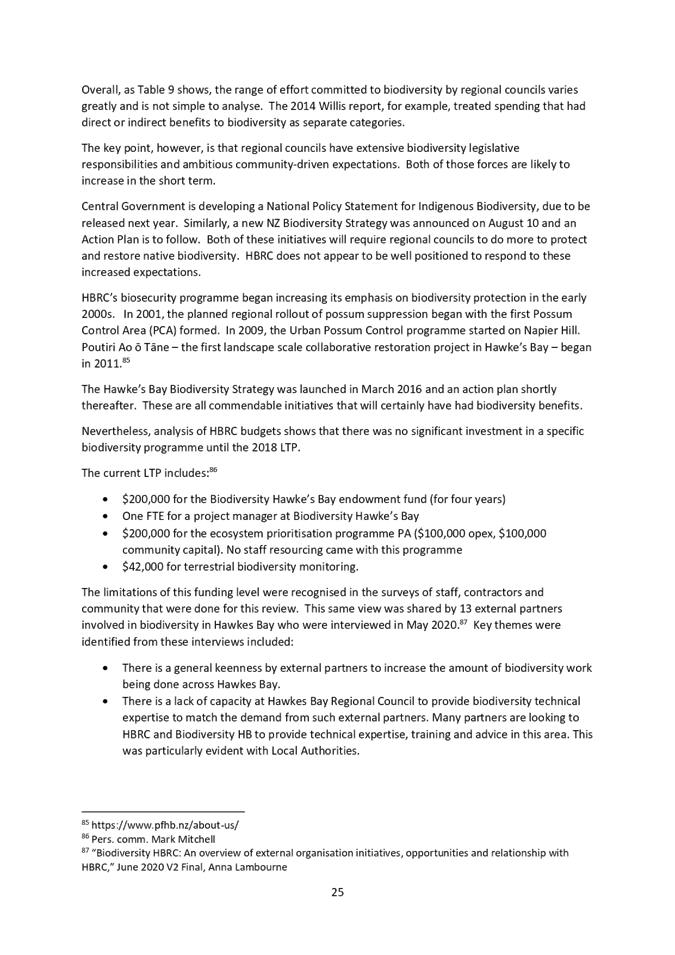
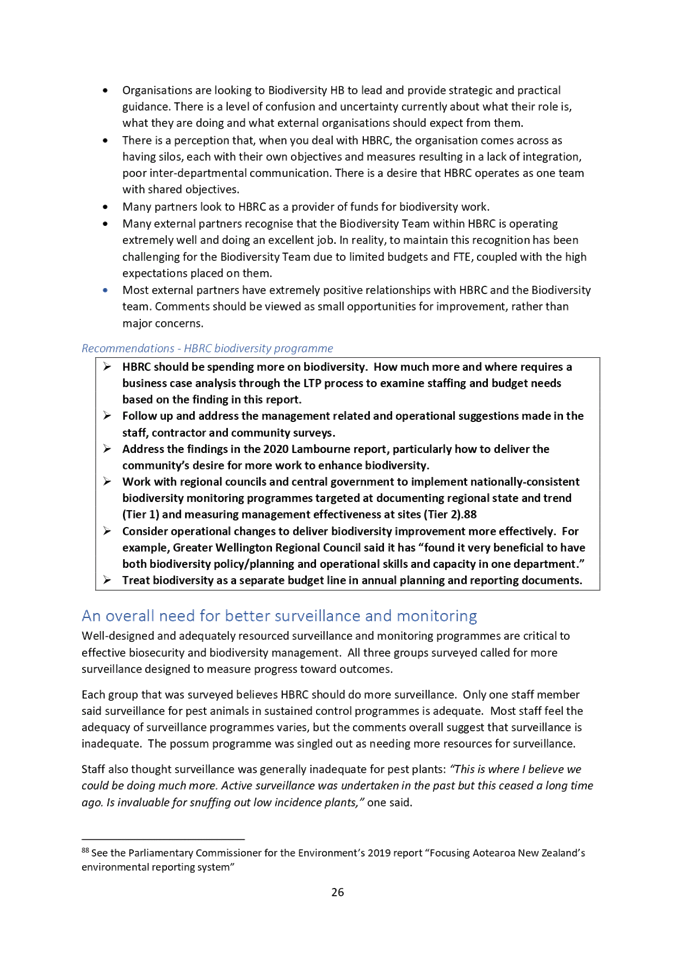
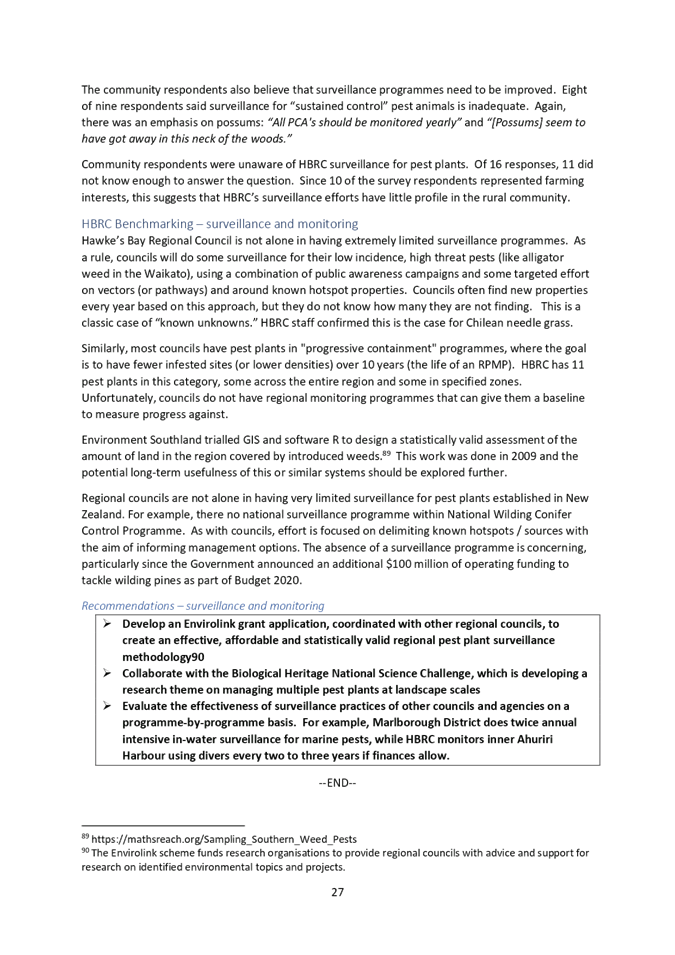
HAWKE’S BAY REGIONAL COUNCIL
Environment
and Integrated Catchments Committee
Wednesday 16 September 2020
Subject: Te Karamu
Reason for Report
1. This item provides the Committee with an update on the progress of
enhancement works undertaken as part of the Te Karamū Enhancement Review
& Management Strategy 2016-25, ‘the Enhancement Strategy’.
Executive
Summary
2. Progress has been made in the priority planting across the 7 zones
and this work is well underway. Of the
9.4ha of priority planting that was identified in the Enhancement Strategy to
be undertaken between 2016-2025, 77% of that has been delivered (7.29 ha), with
100% of the priority planting identified for the Havelock and Irongate zones
having been completed.
3. The challenge is now keeping pace with the demand and expectations
from the community. This has meant the last 12 months has seen focus on
coordinating, supporting, and enabling the community, partners, and corporate
sponsors involvement.
4. The implementation plan was approved by
Council in 2016 is being updated to reflect increase in demand and
propose to reset priorities so as to keep pace and align with the expectations
of this highly valued community initiative and but also be aware of the
original expectations and drivers set in the original document.
5. The program is funded from targeted rates
collected from Karamū ratepayers
each year for this project of $234,000.
Strategic Fit
6. The Enhancement Strategy shares the HBRC vision for a region with a
‘vibrant community, a prosperous economy, a clean and healthy
environment’, now and for future generations, with an overarching purpose
‘to improve habitat and ecosystem health whilst providing flood and
erosion protection’.
7. The Enhancement Strategy provides a toolbox to enable the
Karamū Stream and its tributaries to be maintained as a highly valued
asset to Hawke’s Bay, providing a vision for:
7.1 A
balancing of values where grazing, native vegetation, and recreational areas
support a rich and abundant ecosystem that is accessible and easily managed.
7.2 A
network of clean healthy waterways, connecting and unifying the residents of
the Heretaunga Plains.
7.3 An
asset and resource that supports the cultural, commercial, social and
recreational needs of the community.
8. This enhancement programme also directly aligns to the values
outlined in the Hawke’s Bay Regional Parks Network Plan for the
management of open space, and contributes to the Hawke’s Bay Biodiversity
Strategy 2015-2050.
Background
9. The ‘Te Karamū Catchment Review and options for
Enhancement (2004)’ report provides thorough analysis and detailed
recommendations for the management of The Karamū catchment. Part of the
information formally approved in 2004 included a “Rough Order Cost
Estimation” and it was recommended that staff would develop further
detailed proposed work program.
10. In 2007 a draft Karamū Revegetation Strategy and Concept Plan
was developed and site-specific earthwork and planting plans. Community
support, engagement and awareness has grown with the maturing of the initial
enhancement project and the 2016 strategy assists to further progress and
direct the management of this valuable assets by the HBRC on behalf of
residents of Hawke’s Bay.
11. Te Karamū Stream and its tributaries are a highly valued asset
and resource that supports the cultural, commercial, social and recreational
needs of the community in the Hawke’s Bay.
12. The Enhancement Strategy divided waterways into a series of
zones. These zones are listed in Table
1 below.
Table 1 - Karamū Enhancement Zone
|
Zone
|
Water body
|
Description
|
|
Zone 1 -
Whakatū
|
Karamū-Clive,
Muddy Creek
|
Clive bridge to Karamū/Raupare
confluence.
|
|
Zone 2 -
Ruahāpia
|
Karamū,
Ruahāpia
|
Floodgates to SH2 bridge
|
|
Zone 3 –
Twyford
|
(Excluding
the Twyford targeted rate area)
|
U/s of Karamū/Raupare confluence
|
|
Zone 4 - Waipatu
|
Karamū, Awahou/Windsor/ Riverslea, Mangateretere,
Karitūwhenua
|
SH2 bridge to Crosses Rd bridge
|
|
Zone 5 - Havelock
|
Karamū,
Herehere, Louisa
|
Crosses
Rd bridge to Awanui/ Irongate/Karamū Stream confluence
|
|
Zone 6 - Irongate
|
Irongate,
Southland
|
K5 Irongate-Southland
|
|
Zone 7 -
Awanui, Kārewarewa,
Paritua
|
Awanui,
Kārewarewa, Paritua, Poukawa
|
K3 Awanui, K2
Paritua-Kārewarewa, K1 Poukawa
|
13. This report provides an opportunity to update Council on the
progress of the enhancement work programme.
14. The Enhancement Strategy used a prioritisation criteria to identify
priority enhancement areas for planting between 2016-2025. These areas
make up 8.68% of the total area or 9.4464ha and an annual planting programme
has been undertaken since then to achieve this objective. The table below
outlines the progress of that planting programme between 2016 and 2020.
Table 2 – Priority Planting Progress
|
Zone
|
Identified
priority planting 2016-25
(Ha)
|
Actual Planting 2016-20
(Ha)
|
Percentage of Priority Planting delivered
|
Remaining
Planting 2020-2025 (Ha)
|
|
Zone 1 -
Whakatū
|
1.3266
|
0.397
|
30%
|
0.9296
|
|
Zone 2 -
Ruahāpia
|
4.9250
|
4.2908
|
87%
|
0.6342
|
|
Zone 3 –
Twyford
|
0.00
|
0.0115
|
0%
|
-0.0115
|
|
Zone 4 - Waipatu
|
1.1062
|
0.7427
|
67%
|
0.3635
|
|
Zone 5 - Havelock
|
0.2480
|
0.2480
|
100%
|
0
|
|
Zone 6 - Irongate
|
0.6734
|
0.6734
|
100%
|
0
|
|
Zone 7 -
Awanui, Kārewarewa,
Paritua
|
1.1672
|
0.8464
|
73%
|
0.3208
|
|
Total
|
9.4464
|
7.2908
|
77%
|
2.2366
|
15. On an annual breakdown, there has been a reduction in the area of
priority planting over the last two years, as the initiative has transitioned
from the more accessible planting zones into more focused areas, and as
community engagement and involvement has increased, which requires more
planning and coordination. The 2019/20 autumn planting period was also
impacted by Covid-19 which meant less planting was achieved however staff
expect to be able to make that up in 2020/21.
Table 3 – Annual Planting Area
|
Zone
|
Total Area* (approx. Ha)
|
2016/17
|
2017/18
|
2018/19
|
2019/20
|
Total
|
|
|
|
|
Zone 1 -
Whakatū
|
18.6559
|
0.3830
|
0.0000
|
0.0000
|
0.0140
|
0.3970
|
|
|
Zone 2 -
Ruahāpia
|
21.1462
|
0.7976
|
2.3006
|
0.6081
|
0.5845
|
4.2908
|
|
|
Zone 3 –
Twyford
|
0.0493
|
0.0000
|
0.0000
|
0.0000
|
0.0115
|
0.0115
|
|
|
Zone 4 - Waipatu
|
23.0398
|
0.2735
|
0.1147
|
0.1070
|
0.2475
|
0.7427
|
|
|
Zone 5 - Havelock
|
39.0163
|
0.2480
|
|
|
|
0.2480
|
|
|
Zone 6 - Irongate
|
22.8742
|
0.2205
|
0.4529
|
0.0000
|
0.0000
|
0.6734
|
|
|
Zone 7 - Awanui,
Kārewarewa, Paritua
|
17.7489
|
0.5476
|
0.2797
|
0.0000
|
0.0191
|
0.8464
|
|
|
Total
|
|
2.4702
|
3.1479
|
0.7151
|
0.8766
|
7.2098
|
|
Next
Steps
16. To define future and priorities within the
allocated budget.
17. Staff are in the process of updating
implementation plan to create focus on what is still required to be achieved
and to consider options to match timeframes with community involvement, which
may include speeding up or slowing down some areas. Staff are proposing
to present this plan and possible scenarios to Council later this year.
Decision Making
Process
18. Staff have assessed the requirements of the Local Government Act
2002 in relation to this item and have concluded that, as this report is for
information only, the decision-making provisions do not apply.
|
Recommendation
That the Environment and Integrated
Catchments Committee receives and notes the “Te Karamu”
staff report.
|
Authored by:
|
Martina
Groves
Acting Regional Asset Manager
|
|
Approved by:
|
Chris Dolley
Group Manager Asset Management
|
|
Attachment/s
There are no
attachments for this report.
HAWKE’S BAY REGIONAL
COUNCIL
Environment
and Integrated Catchments Committee
Wednesday 16 September 2020
Subject: Karamu Enhancement
Group Deputation - Management Plan for Parks Reach
Reason for Report
1. This item introduces the deputation from the Karamu Enhancement
Group on a Management Plan for Parks Reach.
Decision Making
Process
2. Staff have
assessed the requirements of the Local Government Act 2002 in relation to this
item and have concluded that, as this report is for information only, the
decision making provisions do not apply.
|
Recommendation
That the Environment and Integration
Catchments Committee receives and notes the “Karamu
Enhancement Group Deputation
- Management Plan for Parks Reach” presented by
John Gould.
|
Authored by:
|
Annelie Roets
Governance Administration Assistant
|
|
Approved by:
|
James Palmer
Chief Executive
|
|
Attachment/s
|
⇩1
|
Karamu
Enhancement Group Deputation
|
|
|
|
Karamu
Enhancement Group Deputation
|
Attachment 1
|
Deputation to Environment and Integrated
Catchment Committee HBRC
re
Park’s Reach
Background
1. Park’s
Reach is that section of Te Karamu stream between the Havelock Roadd Bridge and
the Crosses Rd Bridge. Recent residential development means that the true
right bank is bordered for the whole length by Mary Doyle Villas and other
private housing. Behind its embankment the left bank is bordered by a
commercial shop, open space and a private residence.
2. In the
years 1997-2000 the true right bank between the two bridges was cleared, graded
and grassed by the Hawke’s Bay Regional Council (HBRC). The
adjacent embankment was planted in native trees and shrubs by the St
Columba’s Havelock North Environmental Group (SCHNEG). This work created
an attractive walking area and bird sanctuary which became very popular with
Havelock North residents.
3. In
2012 a similar development of the true left bank, by HBRC, included the
construction of a limestone walking and cycling track.
4. Following
the original development its maintenance has been the responsibility of HBRC,
originally with assistance from the Karamu Enhancement Group (KEG) which looked
after the young trees and shrubs for several years, after which it went into
recess. KEG restarted in 2018 with the aim of getting the maintenance improved.
However the lack of a planned approach, with clear objectives, has resulted in
protracted discussion between KEG and HBRC with issues being dealt with on an
ad hoc basis.
Recent
History
The
area itself.
5. On the
right embankment, while much of the original native planting has thrived, and
significantly increased the bird population of the area, there has also been
significant deterioration due to:
5.1 Originally,
shading by large walnut trees compounding early losses
5.2 Competition
by weeds including blackberry, hemlock and convolvulus
5.3 The
removal of most of the walnut trees in 2016 leaving a number of open spaces
which have reverted to long grass and weeds
5.4 Insufficient
maintenance e.g. on occasions grass on the right bank was allowed to grow to
such a height that it made for difficult, and dangerous, walking both before
and after cutting. (Recent advice is that the number of cuts will be increased
by 2 per year)
5.5 Similarly
long grass and weeds have been allowed to obscure various seats which were
donated at the time of planting
5.6 Dead
trees and shrubs have been allowed to remain for extended periods of time.
6. After
heavy rain or flooding ponding has remained, for extended periods in certain
areas on the grassed area between the native planting on the right embankment
and the stream itself. The inability of water to re-enter the stream
appears to be the result of inappropriate grade and planting along the edge of
the stream this ponding restricts the maintenance and hence walking on the
right bank. An unrelated incident resulting from water leaking from the
Mary Doyle reticulation system has since been rectified.
7. Very
recently a number of trees have been removed from a section of the planting on
the right embankment providing an enhanced viewof the stream itself, for a
number of Mary Doyle properties. However, if this area is to look attractive
and be fire safe the extent of this “opening up” will require
mowing or other means of grass and weed control.
8. Not
withstanding the above, the interest and co-operation of HBRC staff responsible
for and working in the area is acknowledged with appreciation. Recent advice of
an increase in resource allocation is also welcome.
9. The
recent residential development mentioned above has created increased use of the
area and awareness of the above deficiencies. A number of residents have spent
considerable time maintaining areas of the planting.
Other
10.
It
is recognised that Park’s Reach is of small significance within
the wider activities of the HBRC however, it is significant to
the people of Havelock North who pay dedicated rates of approximately
$140,000pa towards its maintenance and enhancement. This significance is
particularly so for those who walk the area regularly and those who live right
next door.
11. In
this context the opening section of Council’s Mission Statement is
particularly relevant “Enhancing our environment together”.
12. The
following submission which, if adopted, would make for a clearer understanding
between all parties, is made on behalf KEG, the Mary Doyle Retirement Complex,
SCHNEG and local residents.
Submission
13.
It
is respectfully submitted that the HBRC, in consultation with the above
submitters, places greater emphasis on the ongoing maintenance and future
development of Park’s Reach.
14.
It
is suggested that such emphasis would be best achieved by the development of a
management plan for the area together with appropriate budget provision.
John
Gould
September
2020
HAWKE’S BAY REGIONAL COUNCIL
Environment
and Integrated Catchments Committee
Wednesday 16 September 2020
Subject: Haumoana Ecology Group
Deputation - Working with HBRC to Enhance Cape Coast Wetlands Ecology
Reason for Report
1. This item introduces the deputation from the Cape Coast Conservation
Group on working with HBRC to Enhance the Cape Coast Wetlands Ecology.
Decision Making
Process
2. Staff have
assessed the requirements of the Local Government Act 2002 in relation to this
item and have concluded that, as this report is for information only, the
decision making provisions do not apply.
|
Recommendation
That the Environment and Integrated
Catchments Committee receives and notes the deputation from the “Haumoana Ecology Group” presented by Liz Remmerswaal.
|
Authored by:
|
Annelie Roets
Governance Administration Assistant
|
|
Approved by:
|
James Palmer
Chief Executive
|
|
Attachment/s
|
⇩1
|
Deputation
from the Haumoana Ecology Group
|
|
|
|
Deputation
from the Haumoana Ecology Group
|
Attachment 1
|
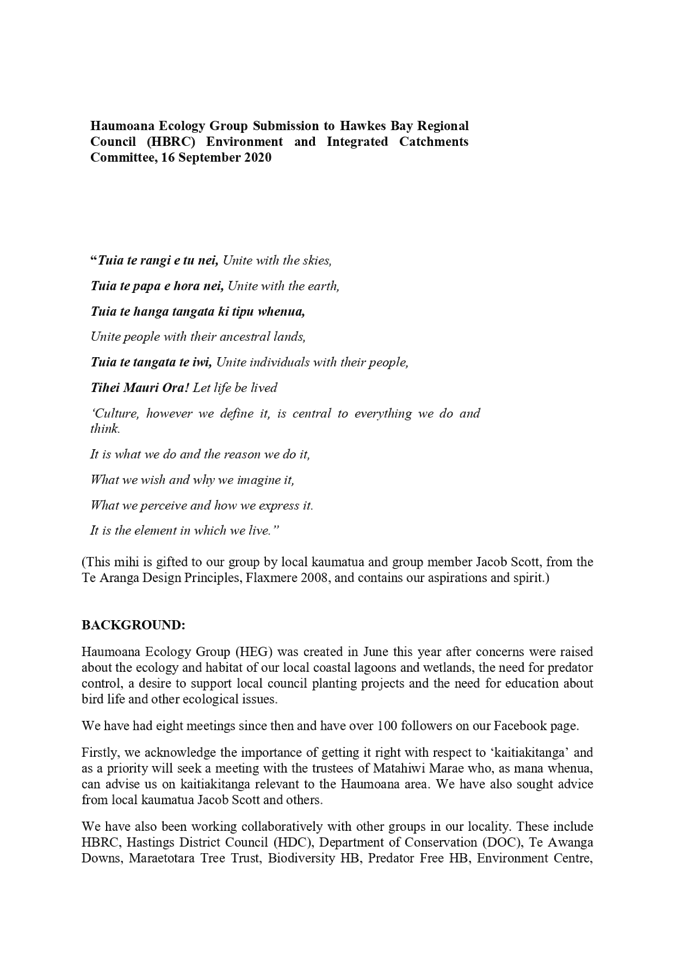
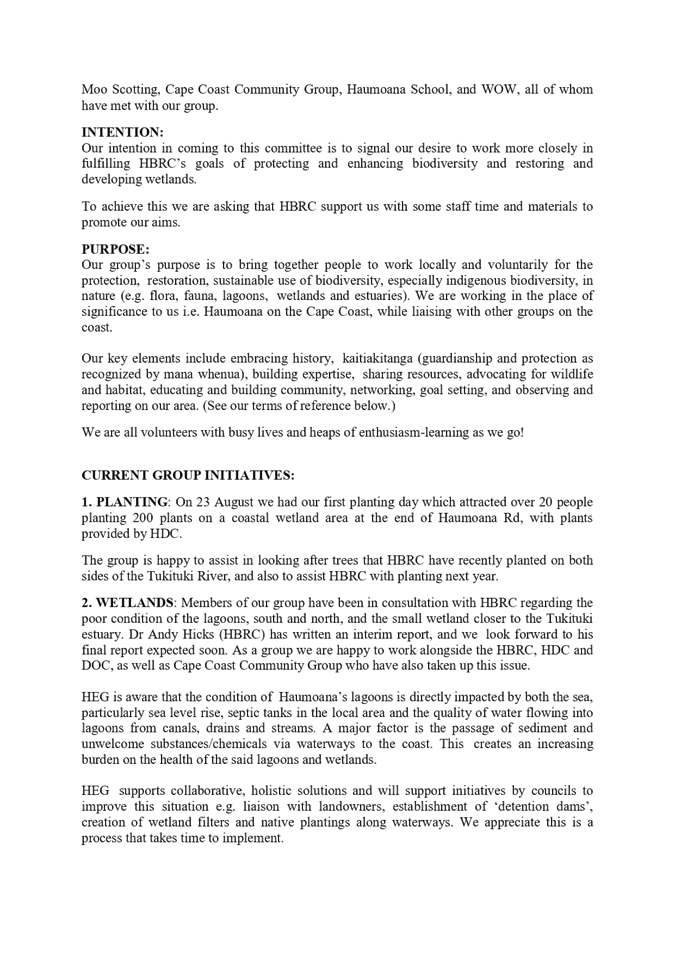
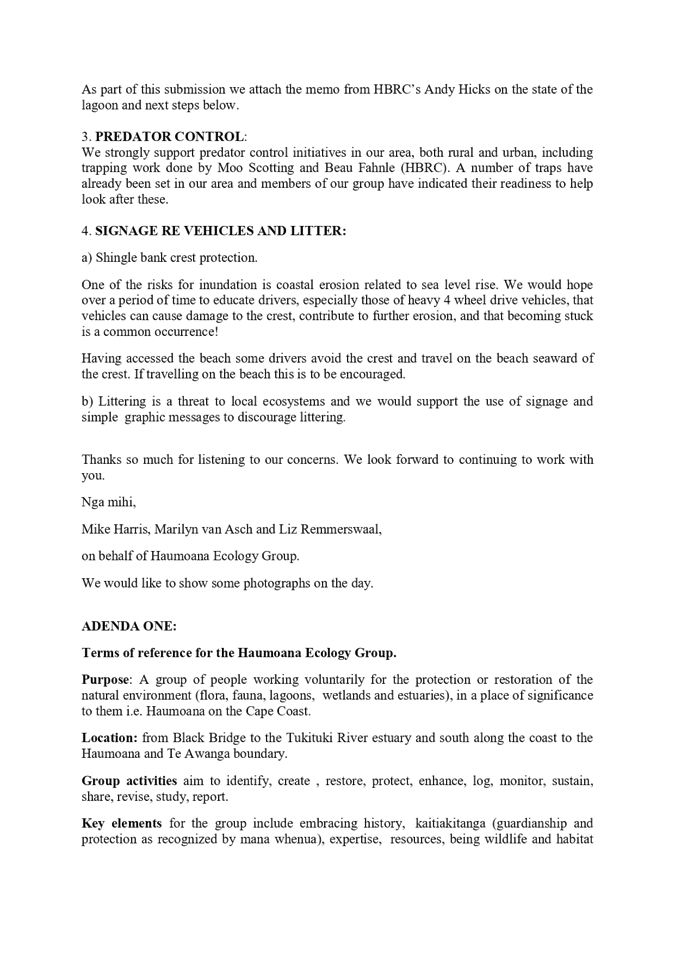
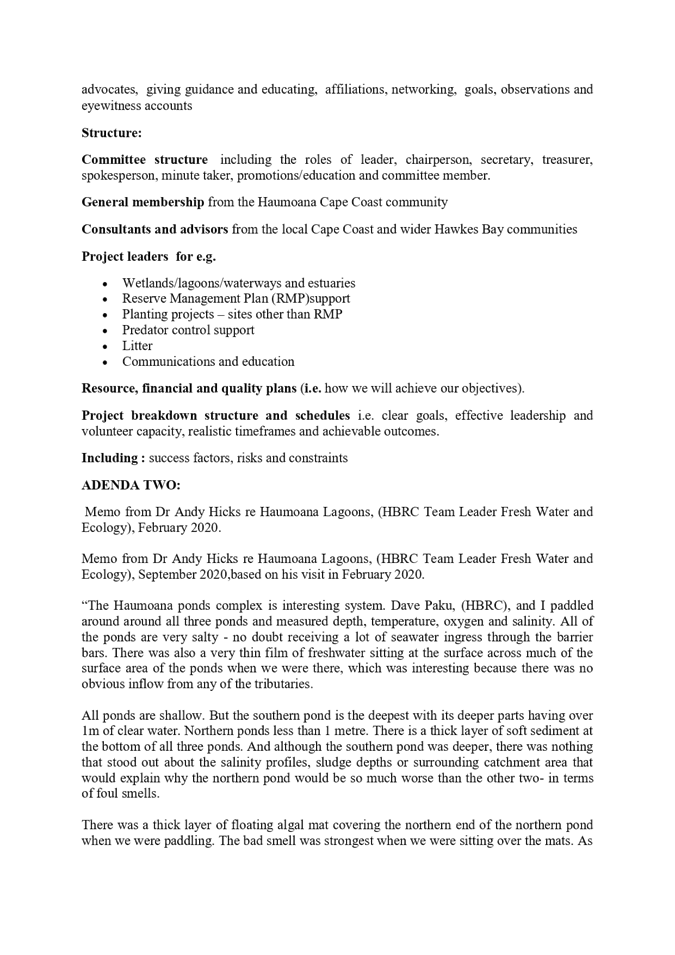
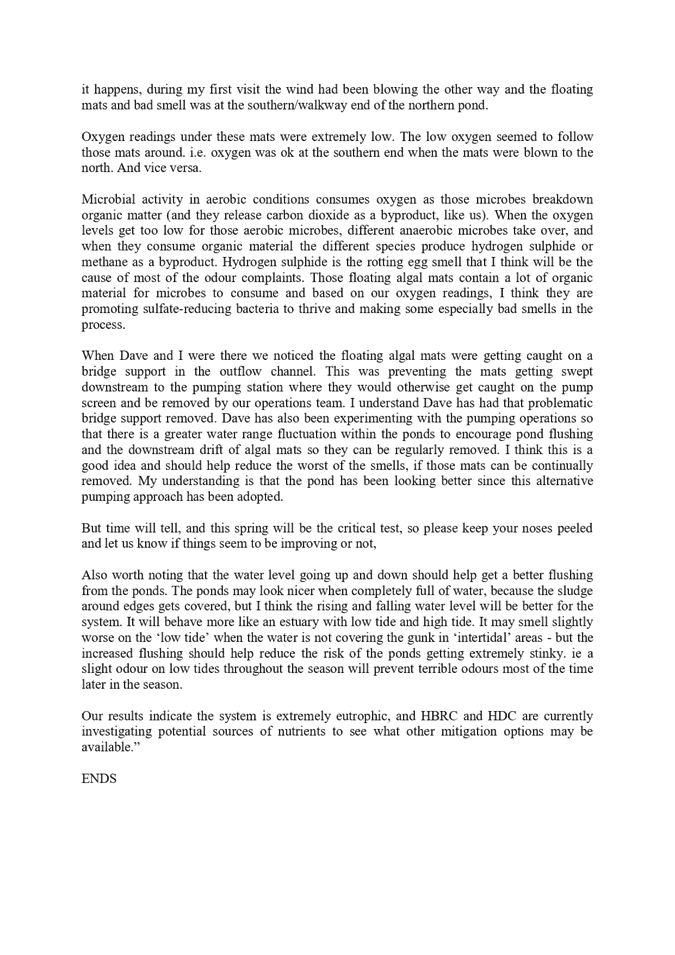
HAWKE’S BAY REGIONAL COUNCIL
Environment
and Integrated Catchments Committee
Wednesday 16 September 2020
Subject: Forest & Bird
Napier Branch Deputation - Little Bush Reserve
Reason for Report
1. This item introduces the deputation from the Napier branch of Forest
& Bird on the Little Bush Reserve.
Decision Making
Process
2. Staff have
assessed the requirements of the Local Government Act 2002 in relation to this
item and have concluded that, as this report is for information only, the
decision making provisions do not apply.
|
Recommendation
That the Environment and Integrated
Catchments Committee receives and notes the “Forest
& Bird Napier Branch Deputation - Little Bush Reserve” presented by
David Belcher.
|
Authored by:
|
Annelie Roets
Governance Administration Assistant
|
|
Approved by:
|
James Palmer
Chief Executive
|
|
Attachment/s
|
⇩1
|
Forest and
Bird letter re Little Bush Fencing
|
|
|
|
⇩2
|
Forest and
Bird Little Bush Presentation
|
|
|
|
Forest
and Bird letter re Little Bush Fencing
|
Attachment 1
|
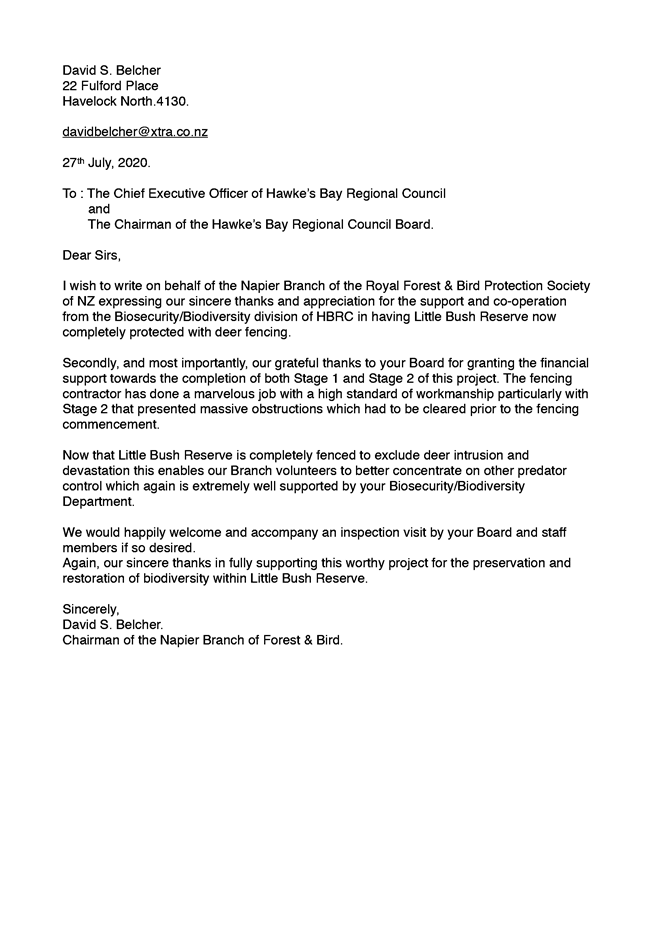
|
Forest and Bird Little Bush
Presentation
|
Attachment 2
|
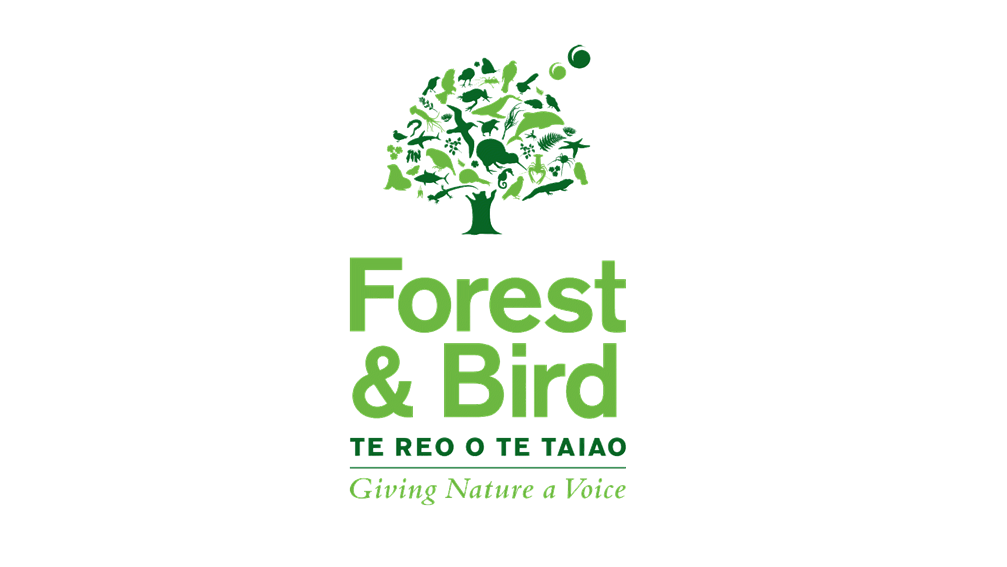
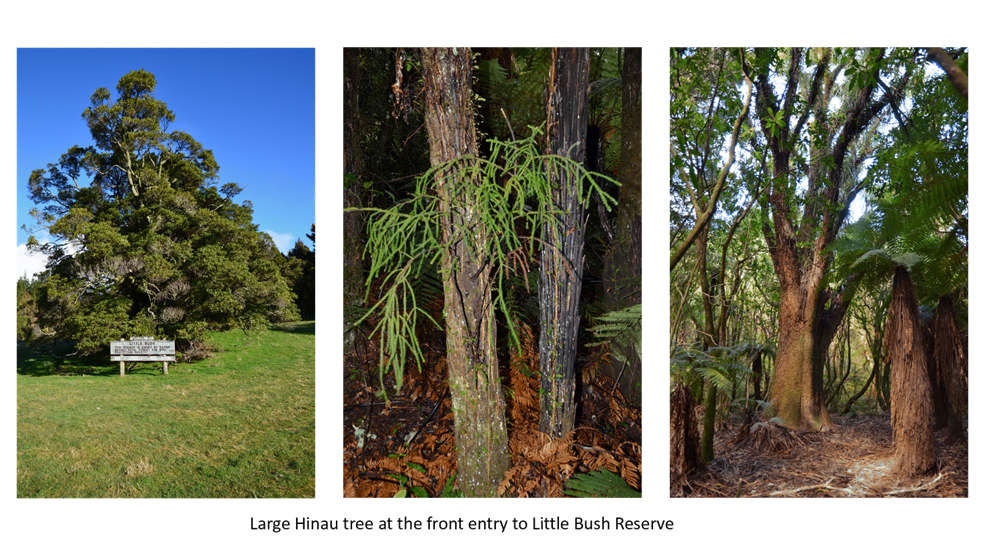
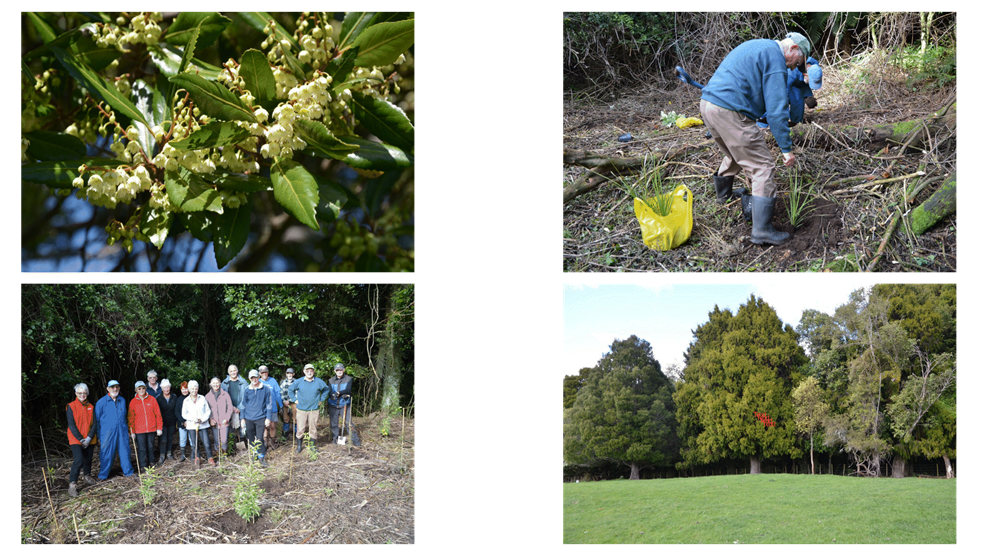
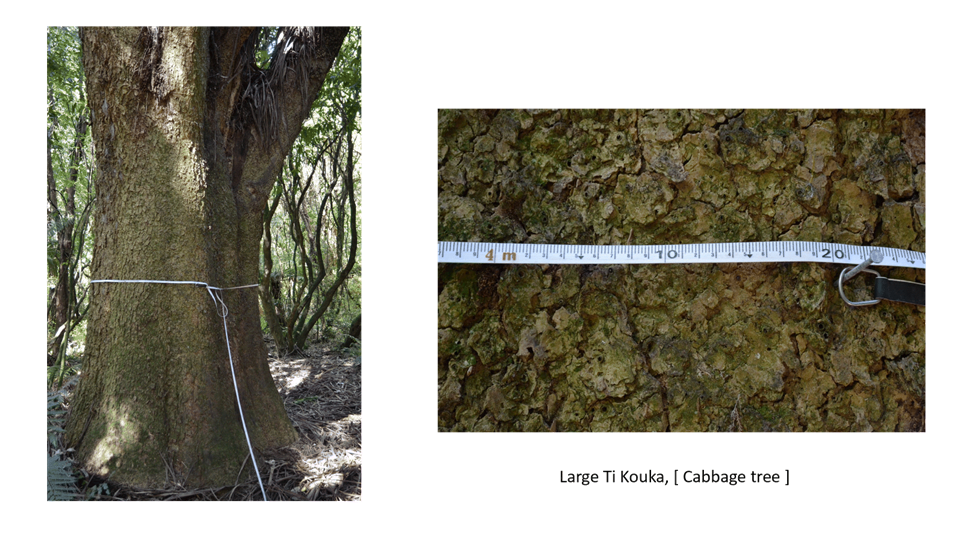
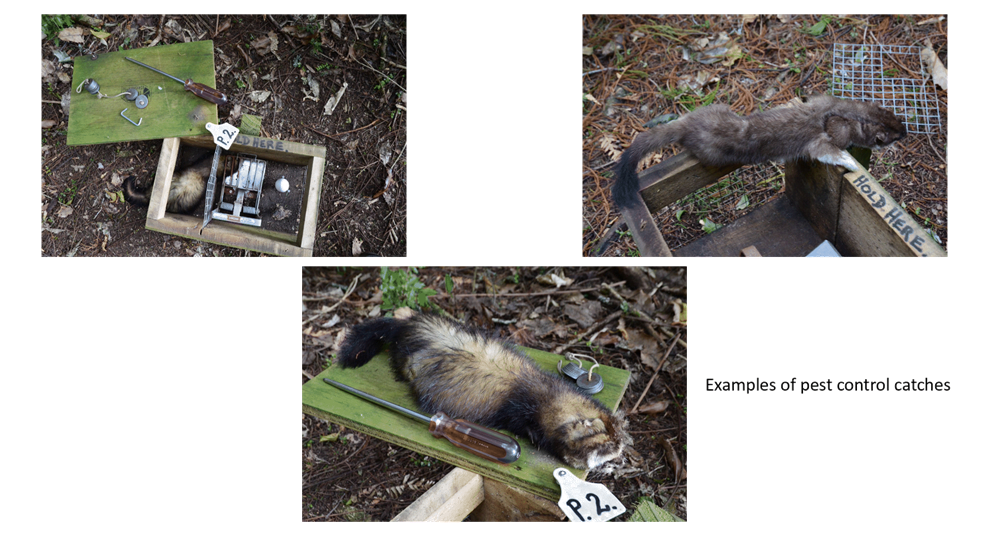
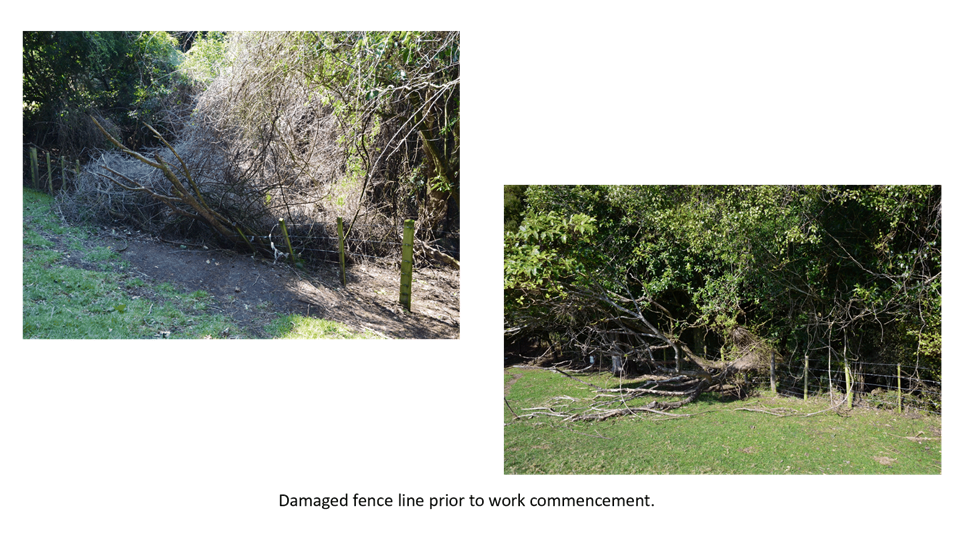
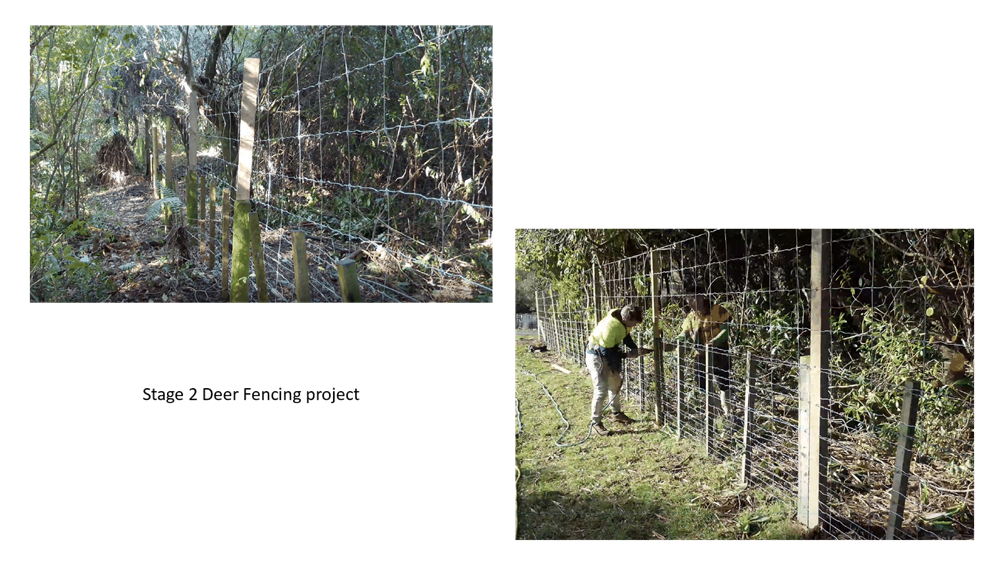
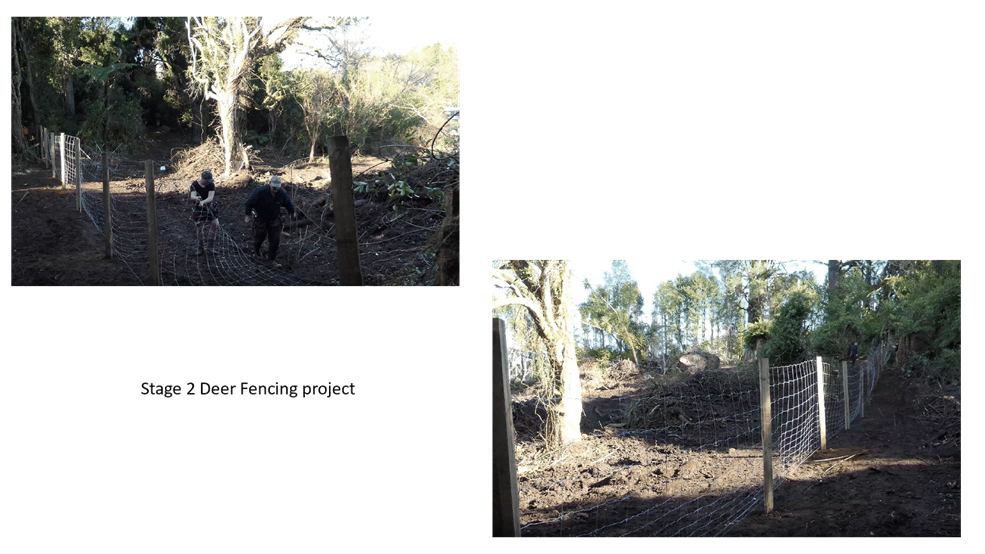
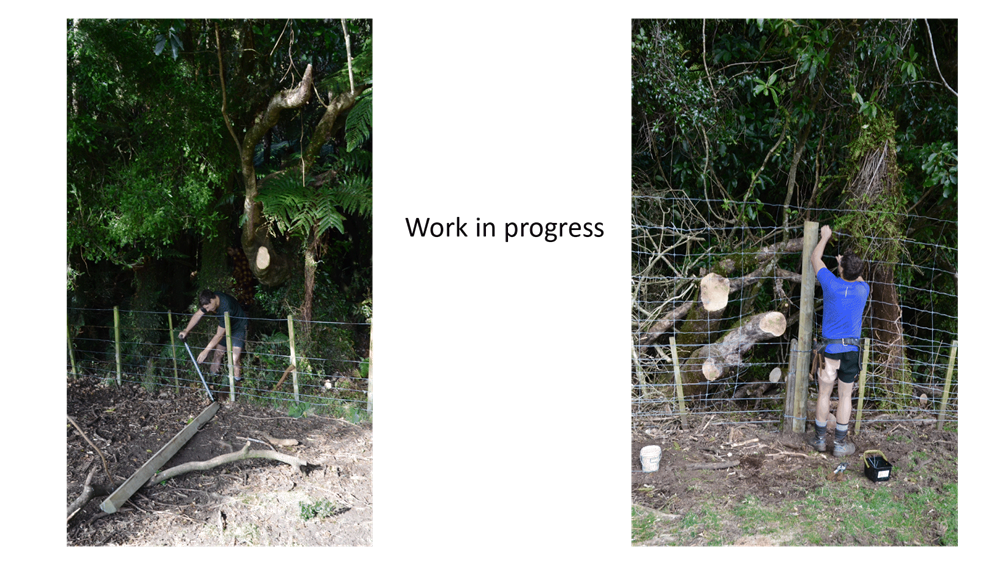
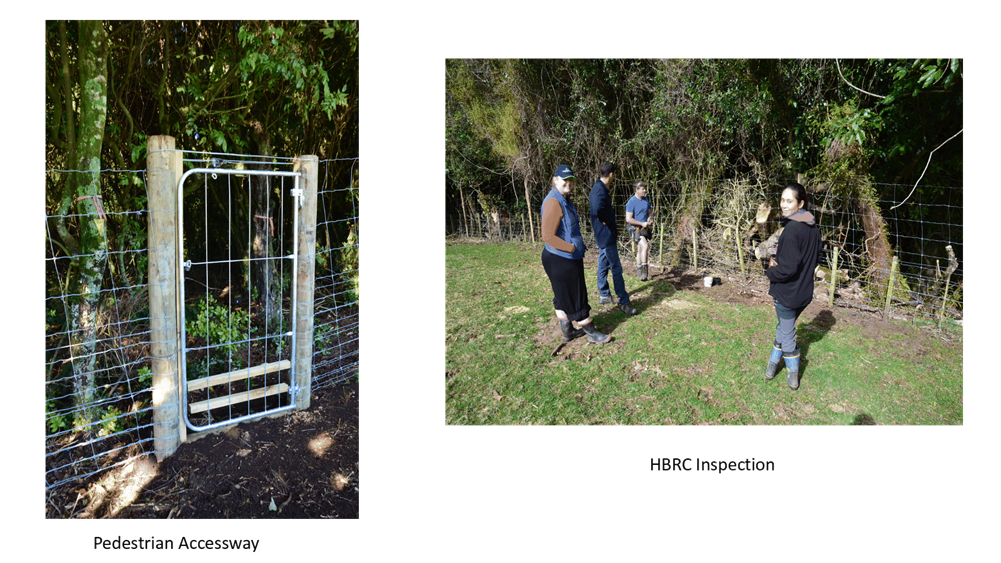
HAWKE’S BAY REGIONAL COUNCIL
Environment
and Integrated Catchments Committee
Wednesday 16 September 2020
Subject: Discussion of Minor
Matters Not on the Agenda
Reason for Report
1. This document has been prepared to assist
Committee members note the Minor Items to be discussed as determined earlier in Agenda Item
5.
HAWKE’S BAY REGIONAL COUNCIL
Environment
and Integrated Catchments Committee
Wednesday 16 September 2020
SUBJECT: CONFIRMATION
OF PUBLIC EXCLUDED MINUTES OF THE ENVIRONMENT AND INTEGRATED CATCHMENTS
COMMITTEE MEETING HELD ON 1 JULY 2020
That Hawke’s Bay Regional Council
excludes the public from this section of the meeting being Confirmation of
Public Excluded Minutes Agenda Item 16 with the general subject of the item to be
considered while the public is excluded; the reasons for passing the resolution
and the specific grounds under Section 48 (1) of the Local Government Official
Information and Meetings Act 1987 for the passing of this resolution being:
|
|
GENERAL SUBJECT OF THE ITEM TO BE
CONSIDERED
|
REASON FOR PASSING THIS RESOLUTION
|
GROUNDS UNDER SECTION 48(1) FOR THE
PASSING OF THE RESOLUTION
|
|
Whittle Reserve
|
s7(2)(i) That the public conduct of
this agenda item would be likely to result in the disclosure of information
where the withholding of the information is necessary to enable the local
authority holding the information to carry out, without prejudice or
disadvantage, negotiations (including commercial and industrial
negotiations)
|
The Council is specified, in the First
Schedule to this Act, as a body to which the Act applies.
|
|
Waipatiki Reserve
|
s7(2)(i) That the public conduct of
this agenda item would be likely to result in the disclosure of information
where the withholding of the information is necessary to enable the local
authority holding the information to carry out, without prejudice or
disadvantage, negotiations (including commercial and industrial
negotiations)
|
The Council is specified, in the First
Schedule to this Act, as a body to which the Act applies.
|
|
Authored by:
|
Leeanne
Hooper
Governance LEAD
|
|
Approved by:
|
James Palmer
Chief Executive
|
|
















































